Cisco is honored to be a accomplice of the Black Hat NOC (Community Operations Middle), because the Official Safety Cloud Supplier. This was our ninth yr supporting Black Hat Asia.
We work with different official suppliers to carry the {hardware}, software program and engineers to construct and safe the Black Hat community: Arista, Corelight, MyRepublic and Palo Alto Networks.
The first mission within the NOC is community resilience. The companions additionally present built-in safety, visibility and automation, a SOC (Safety Operations Middle) contained in the NOC.

On screens outdoors the NOC, accomplice dashboards gave attendees an opportunity to view the amount and safety of the community site visitors.

From Malware to Safety Cloud
Cisco joined the Black Hat NOC in 2016, as a accomplice to offer automated malware evaluation with Menace Grid. The Cisco contributions to the community and safety operations developed, with the wants of the Black Hat convention, to incorporate extra parts of the Cisco Safety Cloud.
Cisco Cloud Safety Suite
When the companions deploy to every convention, we arrange a world-class community and safety operations heart in three days. Our main mission is community uptime, with higher built-in visibility and automation. Black Hat has the decide of the safety trade instruments and no firm can sponsor/purchase their method into the NOC. It’s invitation solely, with the intention of variety in companions, and an expectation of full collaboration.
As a NOC staff comprised of many applied sciences and firms, we’re repeatedly innovating and integrating, to offer an general SOC cybersecurity structure resolution.
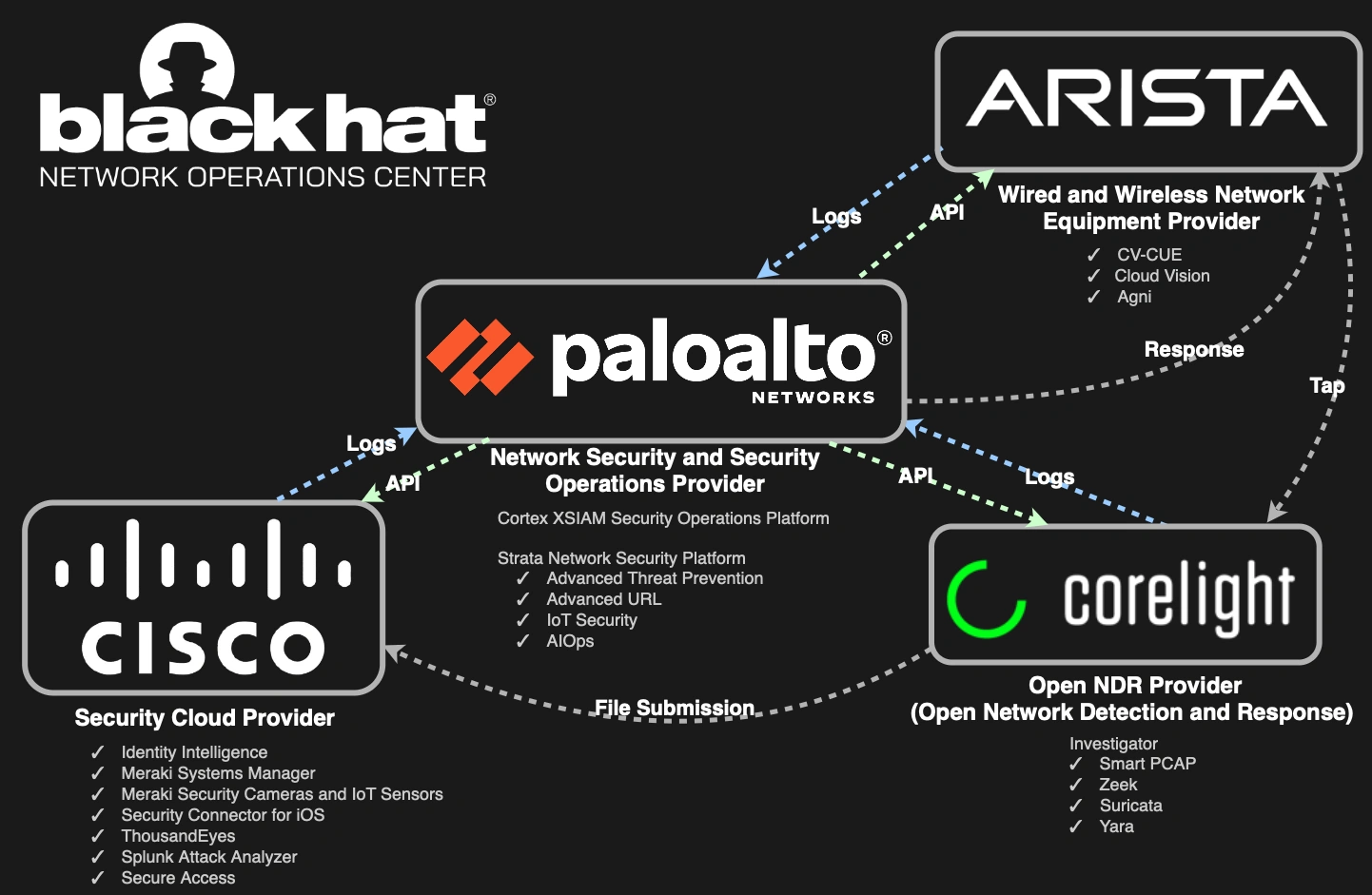
The combination with Corelight NDR and each Safe Malware Analytics and Splunk Assault Analyzer is a core SOC perform. At every convention, we see plain textual content knowledge on the community. For instance, a coaching scholar accessed a Synology NAS over the web to entry SMB shares, as noticed by Corelight NDR. The doc was downloaded in plain textual content and contained API keys & cloud infrastructure hyperlinks. This was highlighted within the NOC Report for example of easy methods to make use of higher safety posture.

Because the malware evaluation supplier, we additionally deployed Splunk Assault Analyzer because the engine of engines, with recordsdata from Corelight and built-in it with Splunk Enterprise Safety.

The NOC leaders allowed Cisco (and the opposite NOC companions) to usher in extra software program and {hardware} to make our inside work extra environment friendly and have better visibility. Nevertheless, Cisco just isn’t the official supplier for Prolonged Detection & Response (XDR), Safety Occasion and Incident Administration (SEIM), Firewall, Community Detection & Response (NDR) or Collaboration.
Breach Safety Suite
- Cisco XDR: Menace Searching, Menace Intelligence Enrichment, Govt Dashboards, Automation with Webex
- Cisco XDR Analytics (previously Safe Cloud Analytics/Stealthwatch Cloud): Community site visitors visibility and menace detection
Splunk Cloud Platform: Integrations and dashboards
Cisco Webex: Incident notification and staff collaboration
As well as, we deployed proof of worth tenants for safety:
The Cisco XDR Command Middle dashboard tiles made it straightforward to see the standing of every of the linked Cisco Safety applied sciences.
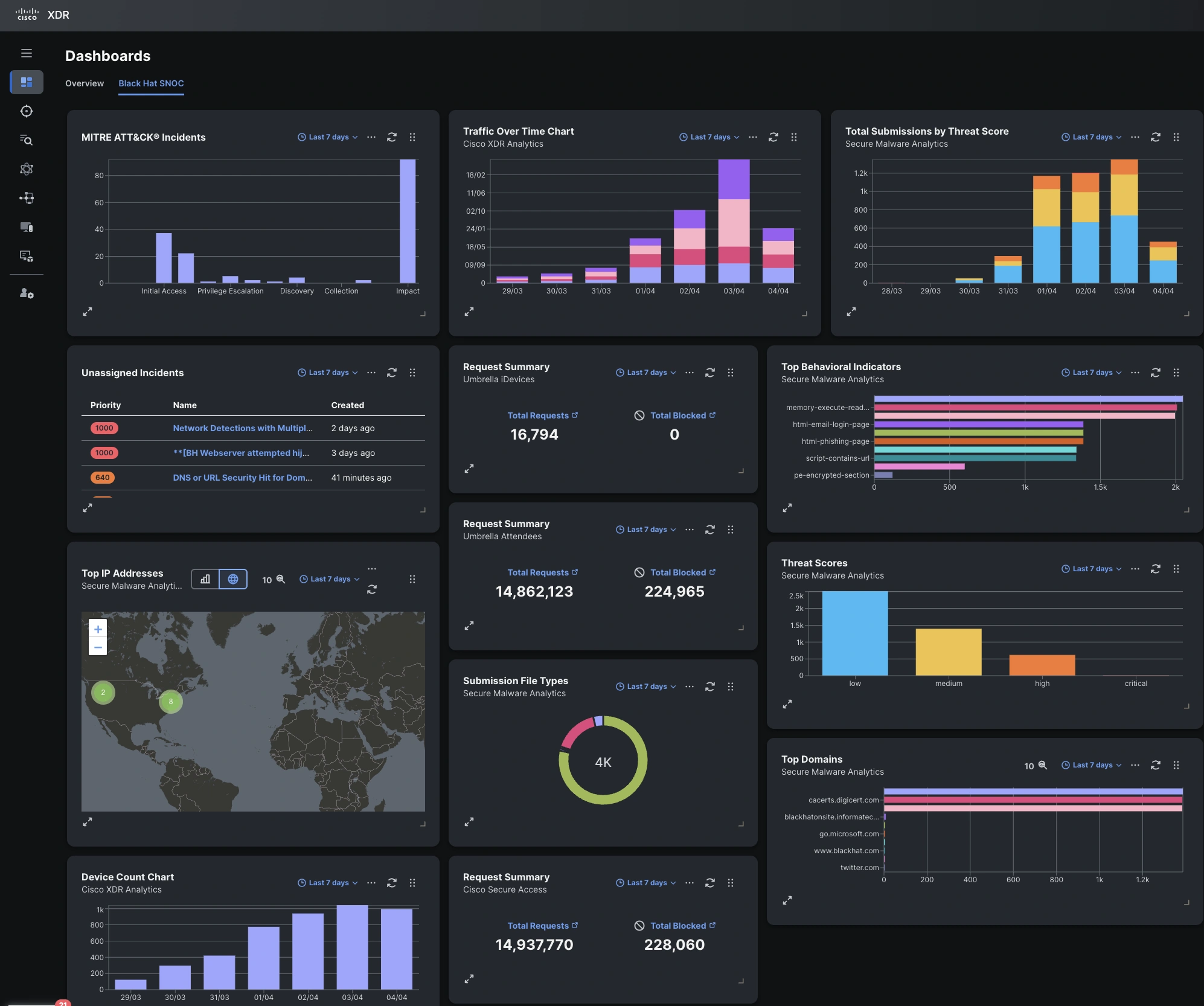
Beneath are the Cisco XDR integrations for Black Hat Asia, empowering analysts to research Indicators of Compromise (IOC) in a short time, with one search.
We respect alphaMountain.ai and Pulsedive donating full licenses to Cisco, to be used within the Black Hat Asia 2025 NOC.
The view within the Cisco XDR integrations web page:
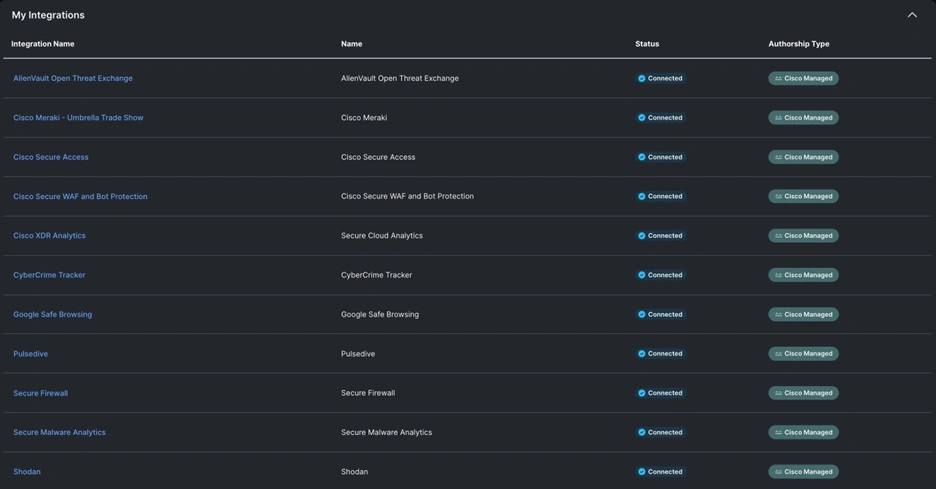
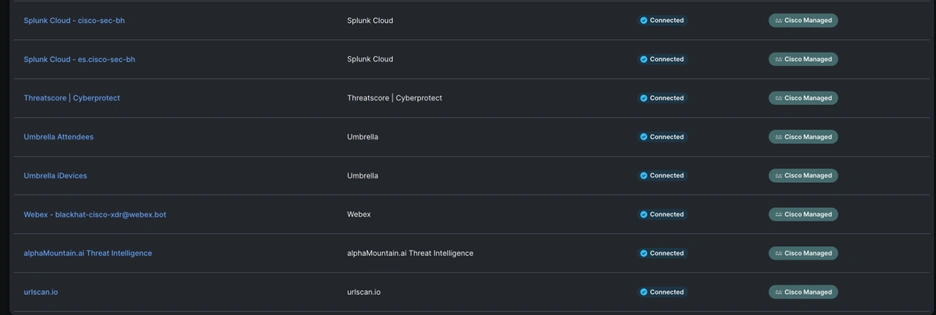
SOC of the Future: XDR + Splunk Cloud
Authored by: Ivan Berlinson, Aditya Raghavan
Because the technical panorama evolves, automation stands as a cornerstone in attaining XDR outcomes. It’s a testomony to the prowess of Cisco XDR that it boasts a completely built-in, strong automation engine.
Cisco XDR Automation embodies a user-friendly, no-to-low code platform with a drag-and-drop workflow editor. This progressive function empowers your SOC to hurry up its investigative and response capabilities. You’ll be able to faucet into this potential by importing workflows throughout the XDR Automate Alternate from Cisco, or by flexing your inventive muscle tissues and crafting your personal.
Bear in mind from our previous Black Hat blogs, we used automation for creating incidents in Cisco XDR from Palo Alto Networks and Corelight.
The next automation workflows had been constructed particularly for Black Hat use instances:
Class: Create or replace an XDR incident
- By way of Splunk Search API — XDR incident from Palo Alto Networks NGFW Threats Logs
- By way of Splunk Search API — XDR incident from Corelight Discover and Suricata logs
- By way of Splunk Search API — XDR incident from Cisco Safe Firewall Intrusion logs
- By way of Splunk Search API — XDR Incident from ThousandEyes Alert
- By way of Umbrella Reporting API — XDR Incident from Umbrella Safety Occasions
- By way of Safe Malware Analytics API — XDR Incident on samples submitted and convicted as malicious
Class: Notify/Collaborate/Reporting
- Webex Notification on new Incident
- Final 6 hours reviews to Webex
- Final 24 hours reviews to Webex
Class: Examine
- By way of Splunk Search API and World Variables (Desk) — Determine Room and Location (incident guidelines on standing new)
- Determine Room and Location (incident playbook)
- Determine Room and Location (Pivot Menu on IP)
- Webex Interactive Bot: Deliberate Observable
- Webex Interactive Bot: Search in Splunk
- Webex Interactive Bot: Determine Room and Location
Class: Report
- XDR incident statistics to Splunk
Class: Correlation
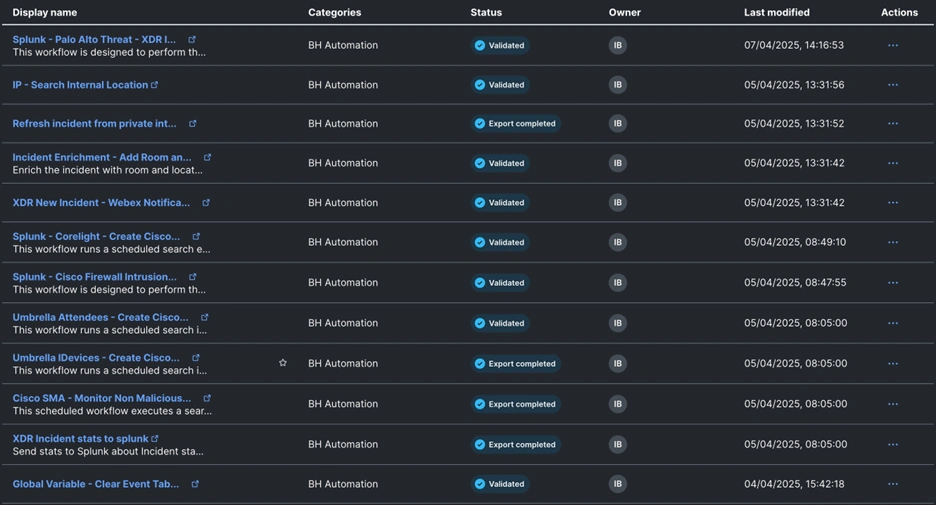
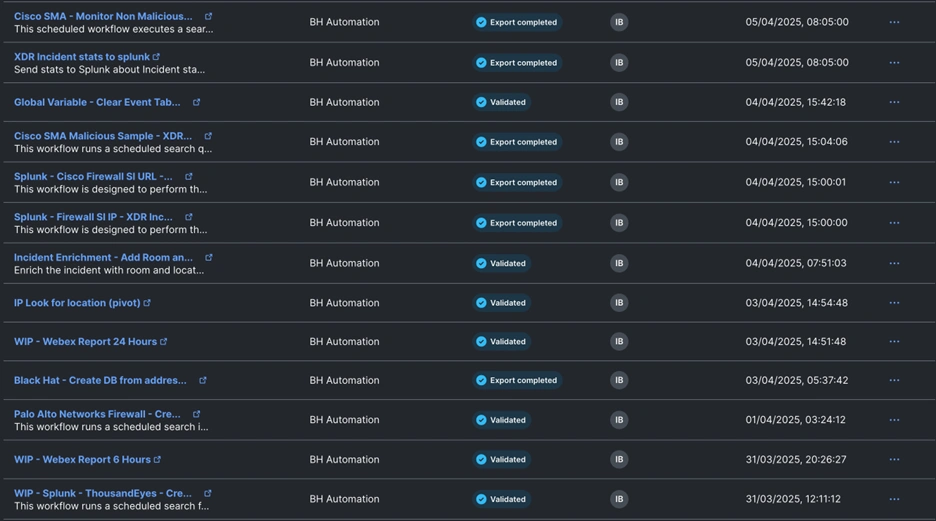
Workflows Description
By way of Splunk Search API: Create or Replace XDR Incident

These workflows are designed to run each 5 minutes and search the Splunk Cloud occasion for brand new logs matching sure predefined standards. If new logs are discovered for the reason that final run, the next actions are carried out for every of them:
- Create a sighting in XDR personal intelligence, together with a number of items of data helpful for evaluation throughout an incident investigation (e.g., supply IP, vacation spot IP and/or area, vacation spot port, approved or blocked motion, packet payload, and so forth.). These alerts can then be used to create or replace an incident (see subsequent steps), but in addition to counterpoint the analyst’s investigation (XDR Examine) like different built-in modules.
- Hyperlink the sighting to an current or a brand new menace indicator
- Create a brand new XDR incident or replace an current incident with the brand new sighting and MITRE TTP.
- To replace an current incident, the workflow makes use of the tactic described under, enabling the analyst to have a whole view of the totally different phases of an incident, and to establish whether or not it might probably be a part of a Coaching Lab (a number of Property performing the identical actions):
- If there may be an XDR incident with the identical observables associated to the identical indicator, then replace the incident
- If not, examine if there may be an XDR incident with the identical observables and provided that the observable sort is IP or Area then replace the incident
- If not, examine if an XDR incident exists with the identical goal asset, then replace the incident
- If not, create a brand new incident
- To replace an current incident, the workflow makes use of the tactic described under, enabling the analyst to have a whole view of the totally different phases of an incident, and to establish whether or not it might probably be a part of a Coaching Lab (a number of Property performing the identical actions):


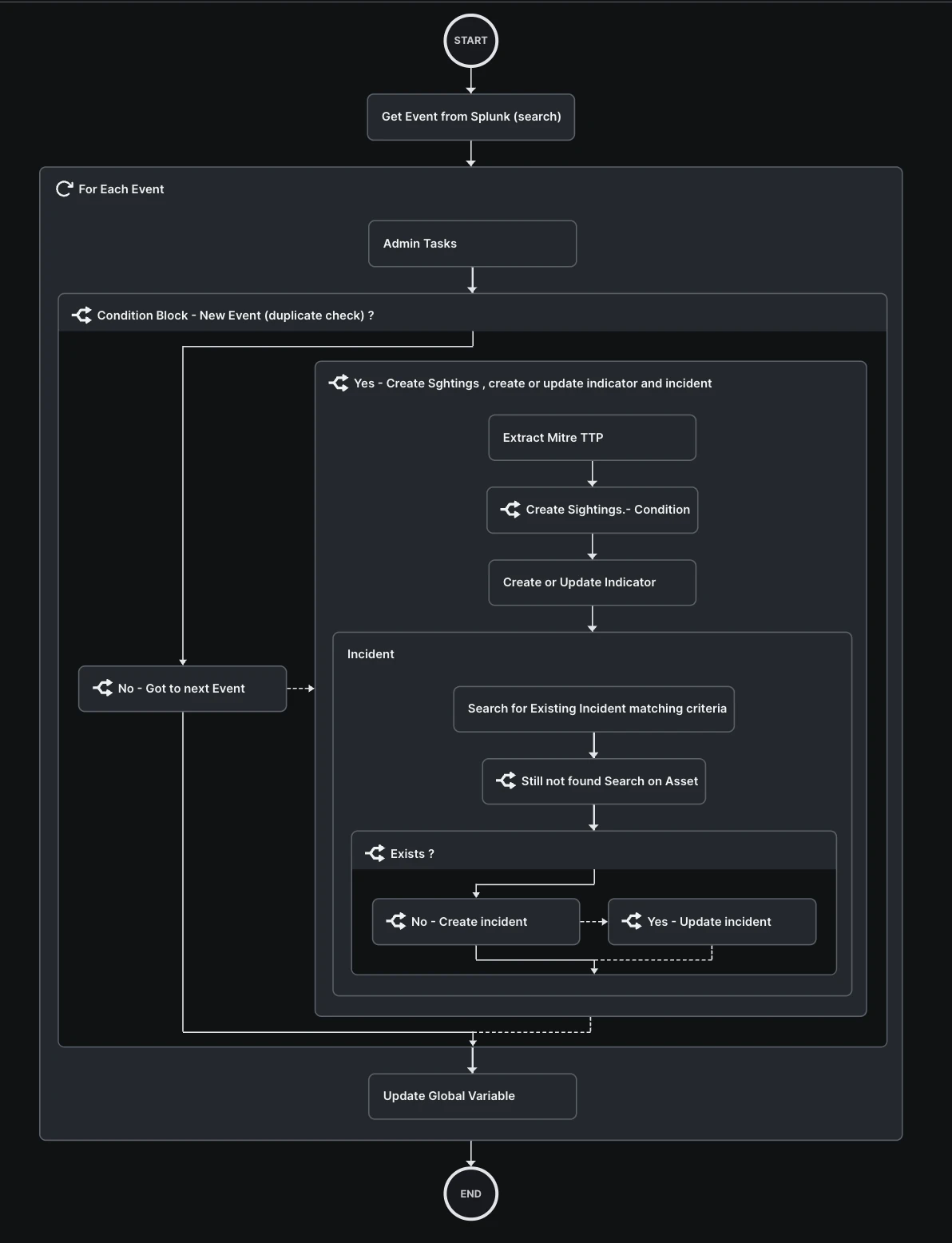
Determine Room and Location
It was necessary for the analysts to acquire as a lot data as attainable to assist them perceive whether or not the malicious habits detected as a part of an incident was a real safety incident with an influence on the occasion (a True Optimistic), or whether or not it was official within the context of a Black Hat demo, lab and coaching (a Black Hat Optimistic).
One of many strategies we used was a workflow to search out out the situation of the property concerned and the aim of it. The workflow is designed to run:
- Routinely on new XDR incident and add the lead to a be aware
- On demand by way of a job within the XDR incident playbook
- On demand by way of the XR pivot menu
- On demand by way of the Webex interactive bot
The workflow makes use of a number of IP addresses as enter, and for every of them:
- Queries an array (world variable XDR), together with the community tackle of every room/space of the occasion and function (Lab XYZ, Registration, Genera Wi-Fi, and so forth.)
- Runs a search in Splunk on Palo Alto Networks NGFW Site visitors Logs to get the Ingress Interface of the given IP
- Run a search in Splunk on Umbrella Reporting Logs to get to the Umbrella Community Identities


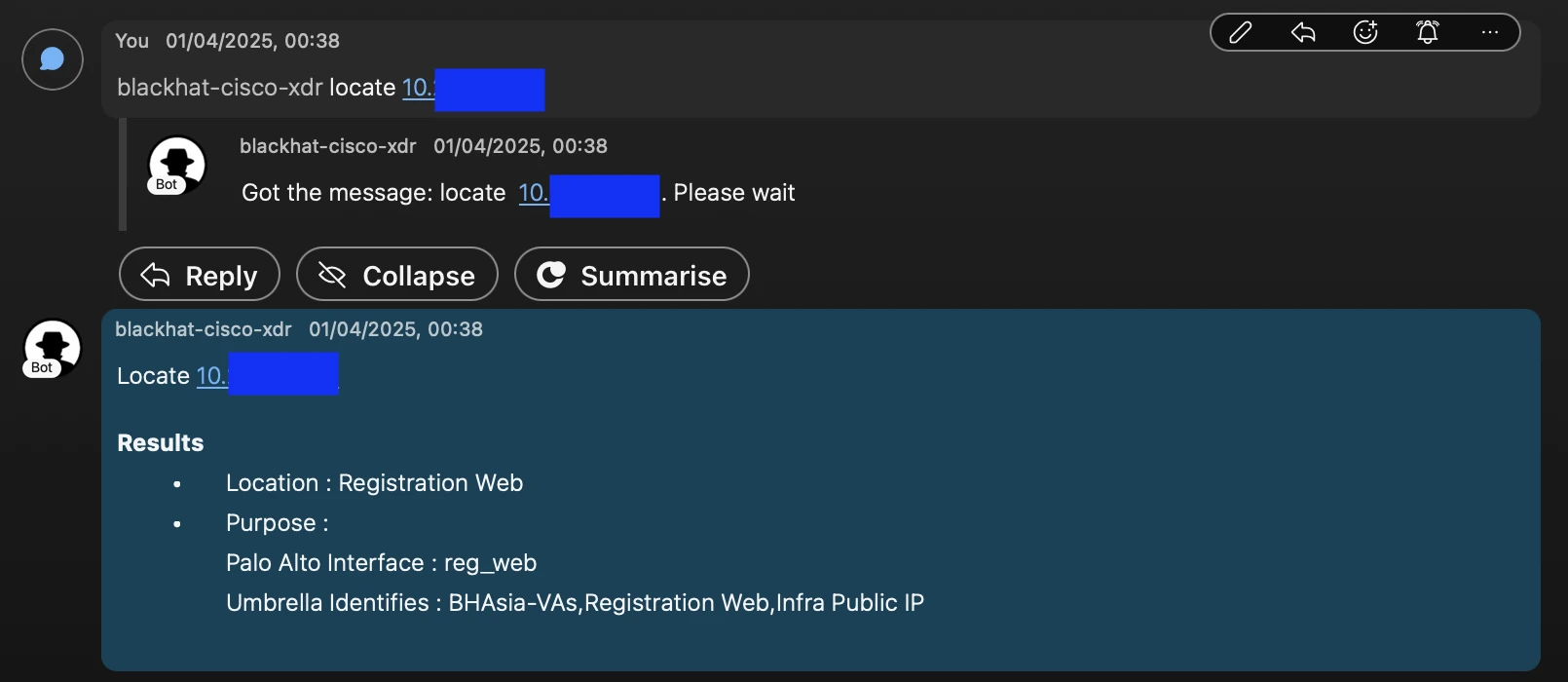

Webex Notification and Interactive Bot
Correct communication and notification are key to make sure no incident is ignored.
Along with Slack, we had been leveraging Cisco Webex to obtain a notification when a brand new incident was raised in Cisco XDR and an interactive Bot to retrieve extra data and assist in step one of the investigation.
Notification
On new incident an automation was triggering a workflow to seize a abstract of the incident, set off the enrichment of the situation and function of the room (see earlier workflow) and ship a Notification in our collaborative room with particulars in regards to the incident and a direct hyperlink to it in XDR.
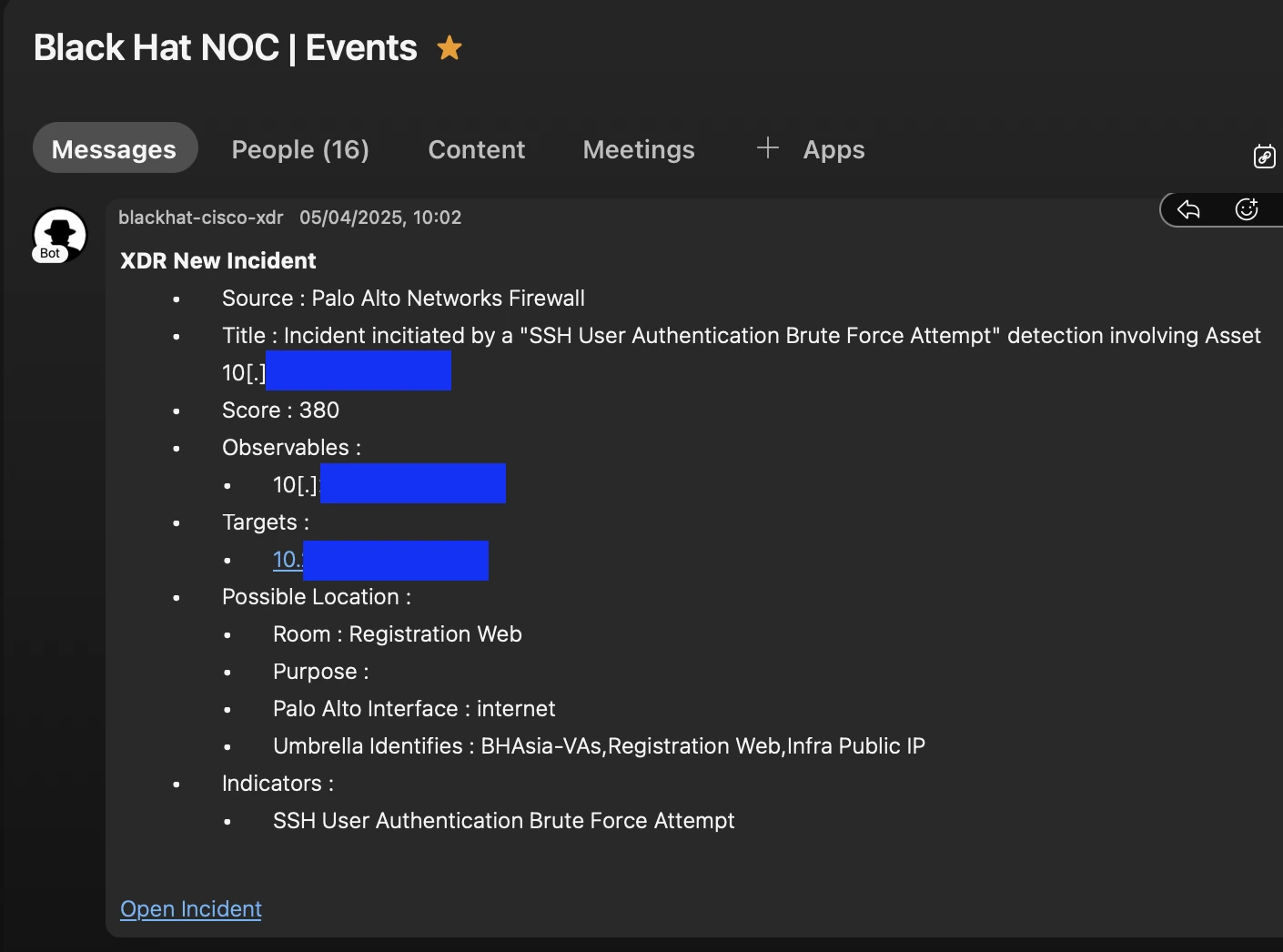

Interactive Bot
An interactive Webex Bot instrument was additionally used to assist the analyst. 4 instructions had been accessible to set off a workflow in Cisco XDR by way of a Webhook and show the consequence as a message in Cisco Webex.
- find [ip] — Seek for location and function for a given IP
- deliberate [observable] — Acquire verdicts for a given observable (IP, area, hash, URL, and so forth.) from the assorted menace intelligence sources accessible in Cisco XDR (native and built-in module)
- splunk — Carry out a Splunk search of all indexes for a given key phrase and show the final two logs
- csplunk [custom search query] — Search Splunk with a customized search question
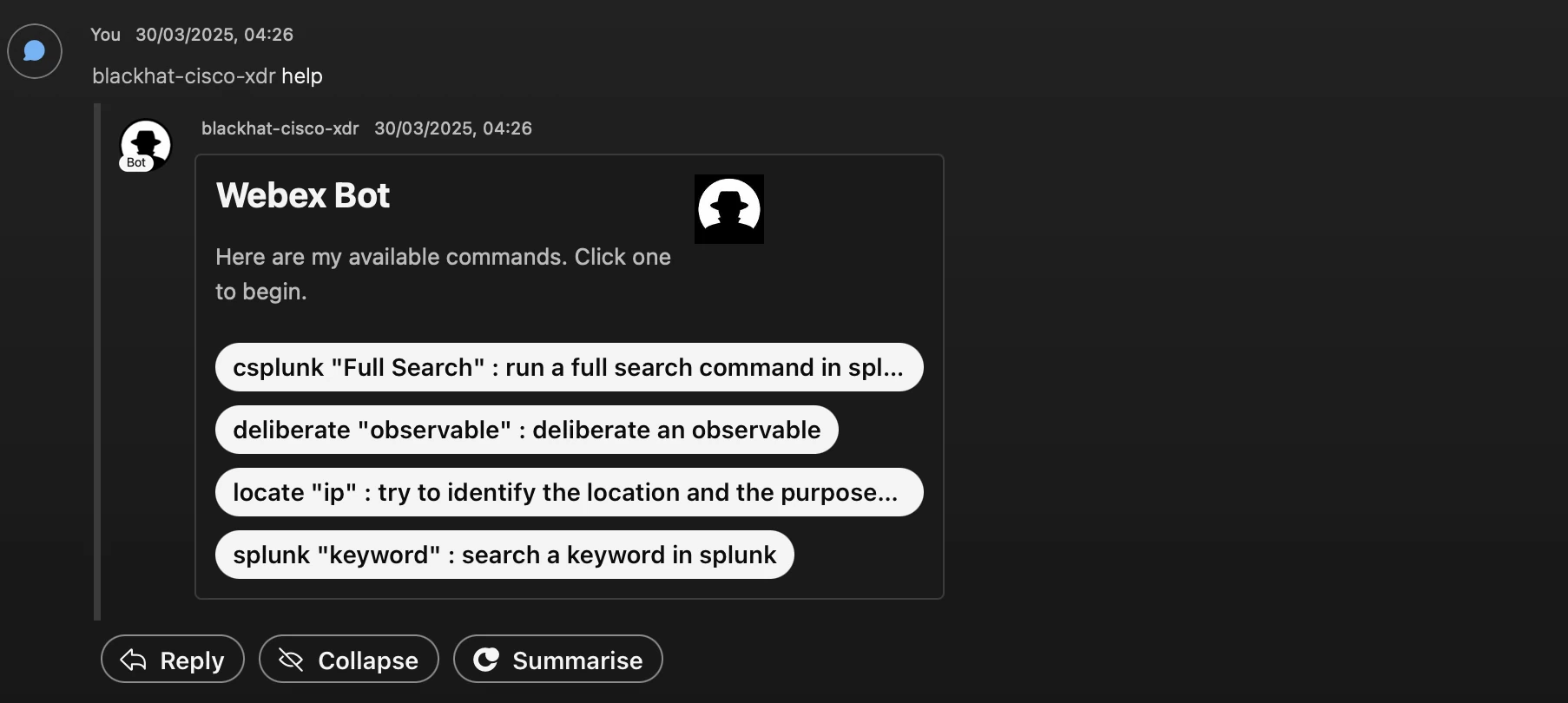
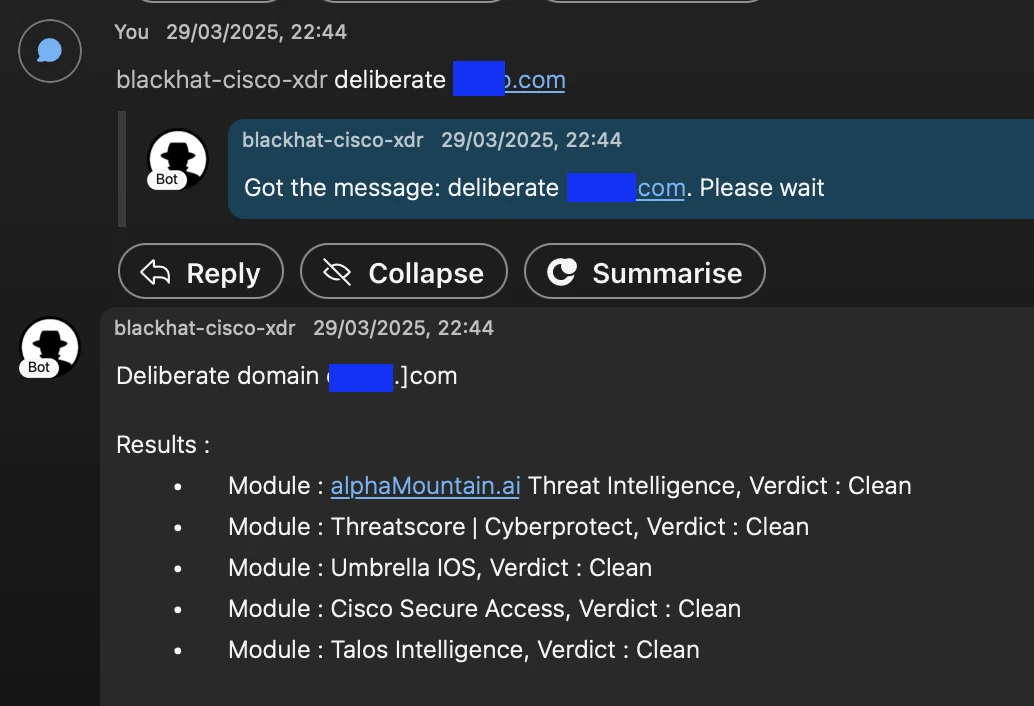

Final 6/24 hours reviews to Webex
Each workflows run each 6 hours and each 24 hours to generate and push to our Webex collaboration rooms a report together with the Prime 5 property, domains and goal IPs within the safety occasion logs collected by Splunk from Palo Alto Networks Firewall, Corelight NDR and Cisco Umbrella (search […] | stats rely by […]).

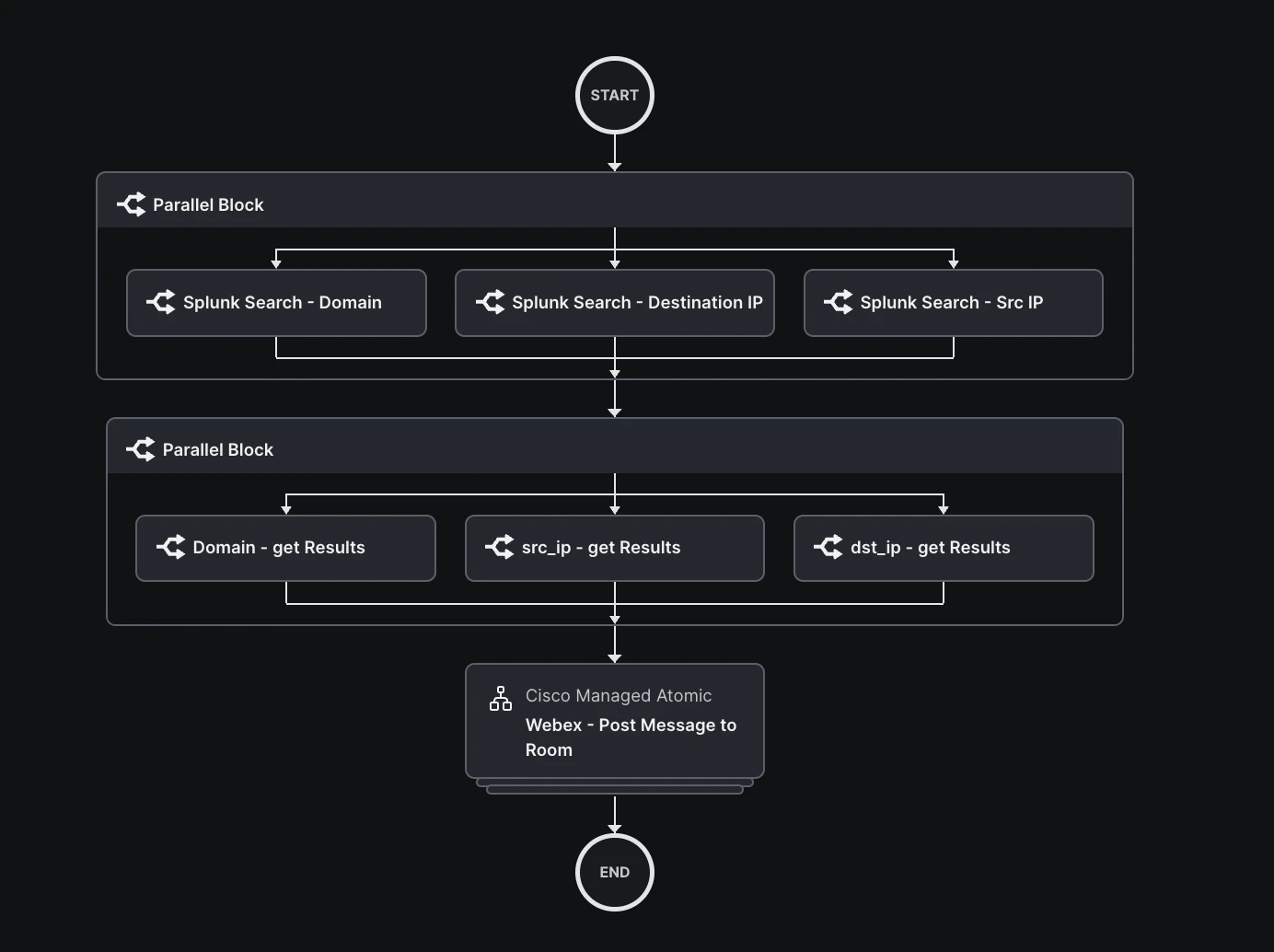
Merge XDR Incident
Cisco XDR makes use of a number of superior methods to establish a sequence of assault and correlate varied associated safety detections collectively in a single incident. Nevertheless, typically solely the analyst’s personal investigation can reveal the hyperlink between the 2. It was necessary for analysts to have the choice, after they uncover this hyperlink, of merging a number of incidents into one and shutting the beforehand generated incidents.
We’ve designed this workflow with that in thoughts.
Throughout the identification part, the analyst can run it from the “merge incident” job within the Incident playbook of any of them.


At runtime, analysts might be prompted to pick the observables which can be half of the present incident that they want to seek for in different incidents that embrace them.

The workflow will then search in XDR for different incidents involving the identical observables and report incidents discovered within the present incident notes.

Analysts are then invited by way of a immediate to resolve and point out the factors on which they want the merger to be based mostly.
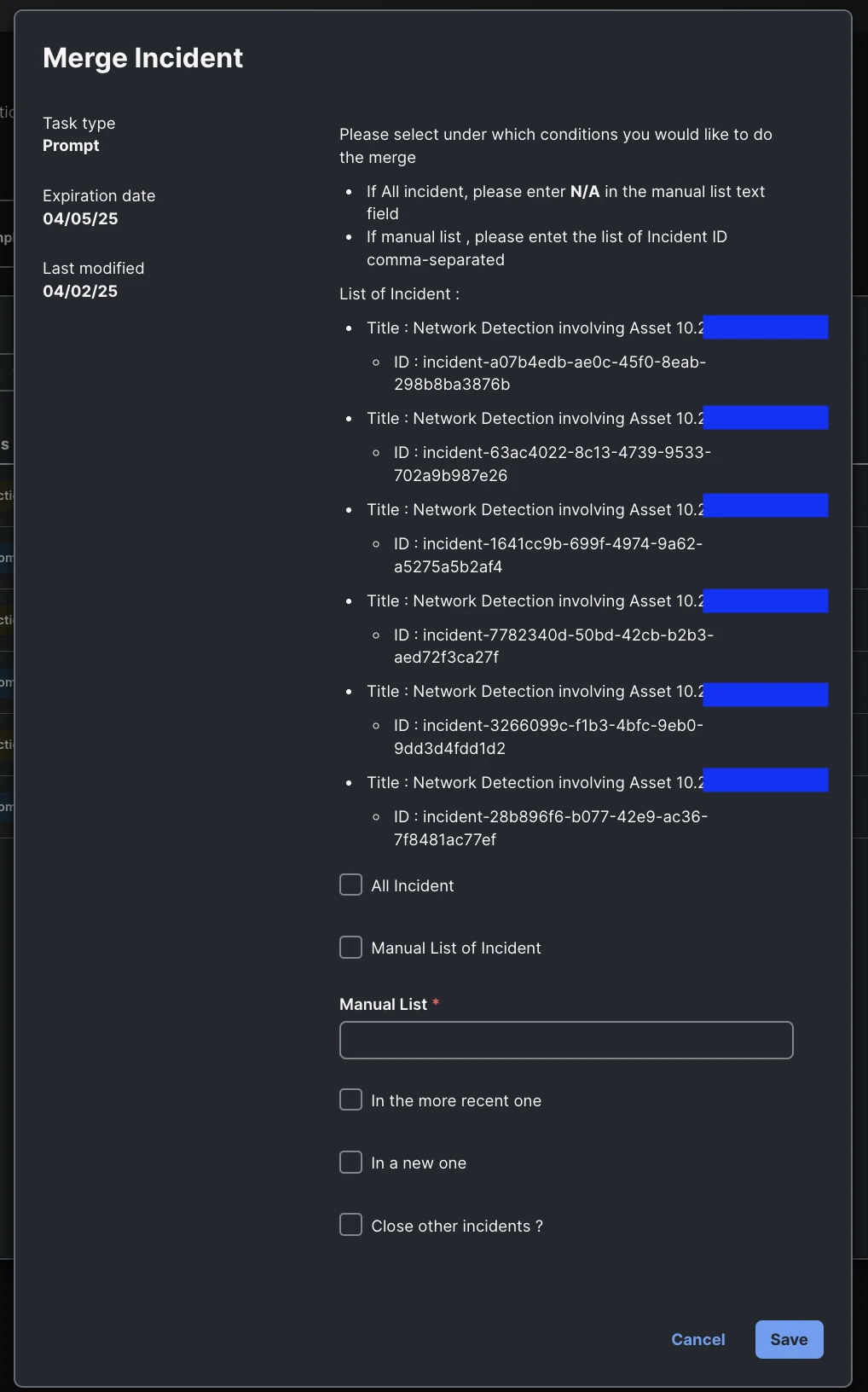
The prompts embrace:
- All incidents — Settle for the checklist of incidents discovered and merge all of them
- Guide lists of incidents — Manually enter the identifier of the incidents you want to merge; the checklist could embrace the identifier of an incident found by the workflow or one other found by the analyst
- Merge in a brand new incident or In the newest one
- Shut different incidents — Sure/No
The workflow then extracts all the data from the chosen incident and creates a brand new one with all this data (or updates the newest incident).

To make our menace hunters’ lives richer with extra context from ours and our companions’ instruments, we introduced in Splunk Enterprise Safety Cloud on the final Black Hat Europe 2024 occasion to ingest detections from Cisco XDR, Safe Malware Analytics, Umbrella, ThousandEyes, Corelight OpenNDR and Palo Alto Networks Panorama and visualize them into practical dashboards for government reporting. The Splunk Cloud occasion was configured with the next integrations:
- Cisco XDR and Cisco Safe Malware Analytics, utilizing the Cisco Safety Cloud app
- Cisco Umbrella, utilizing the Cisco Cloud Safety App for Splunk
- ThousandEyes, utilizing the Splunk HTTP Occasion Collector (HEC)
- Corelight, utilizing Splunk HTTP Occasion Collector (HEC)
- Palo Alto Networks, utilizing the Splunk HTTP Occasion Collector (HEC)
The ingested knowledge for every built-in platform was deposited into their respective indexes. That made knowledge searches for our menace hunters cleaner. Trying to find knowledge is the place Splunk shines! And to showcase all of that, key metrics from this dataset had been transformed into varied dashboards in Splunk Dashboard Studio. The staff used the SOC dashboard from the final Black Hat Europe 2024 as the bottom and enhanced it. The extra work introduced extra insightful widgets needing the SOC dashboard damaged into the next 4 areas for streamlined reporting:
1. Incidents

2. DNS

3. Community Intrusion

4. Community Metrics

With the constitution for us at Black Hat being a ‘SOC inside a NOC’, the chief dashboards had been reflective of bringing networking and safety reporting collectively. That is fairly highly effective and might be expanded in future Black Hat occasions, so as to add extra performance and increase its utilization as one of many main consoles for our menace hunters in addition to reporting dashboards on the big screens within the NOC.
Menace Hunter’s Nook
Authored by: Aditya Raghavan and Shaun Coulter
Within the Black Hat Asia 2025 NOC, Shaun staffed the morning shifts, and Aditya the afternoon shifts as common. In contrast to the sooner years, each hunters had loads of rabbit holes to down into resulting in a spot of “concerned pleasure” for each.
Actions involving malware what can be blocked on a company community have to be allowed, throughout the confines of Black Hat Code of Conduct.
Fishing With Malware: Who Caught the Fish?
It began with uncommon community exercise originating from a tool in a lab class. Doesn’t it all the time?
“Look past the endpoint.”
A saying that involves life each day at Black Hat
That mentioned, a tool was discovered connecting to a web site flagged as suspicious by menace intelligence programs. Subsequent, this web site was being accessed by way of a direct IP tackle which is kind of uncommon. And to prime all of it off, the system exchanged credentials in clear textual content.
Seems like your typical phishing incident, and it raised our hunters’ eyebrows. The preliminary speculation was {that a} system had been compromised in a phishing assault. Given the character of the site visitors — bi-directional communication with a identified suspicious web site — this appeared like a basic case of a phishing exploit. We utilized Cisco XDR to correlate these detections into an incident and visualize the connections concerned.

As is obvious from the screenshot under, a detection from Corelight OpenNDR for attainable phishing kicked this off. Additional investigation revealed comparable site visitors patterns from different gadgets throughout the convention corridor, this time on Normal Wi-Fi community as effectively.

The vacation spot for all of them, 139.59.108.141, had been marked with a suspicious disposition by alphaMountain.ai menace intelligence.
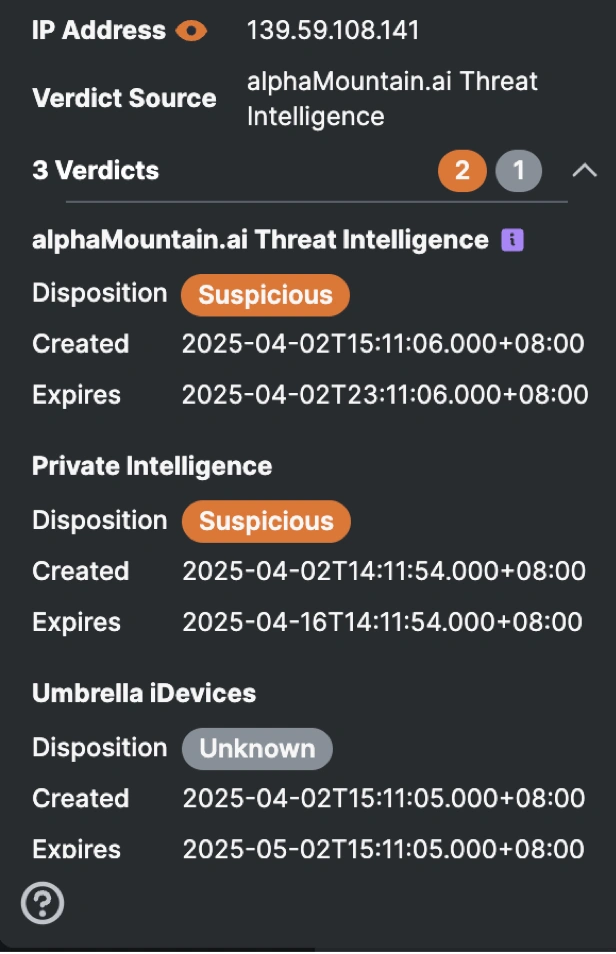
Because of the automation applied to question Umbrella Identities, the system’s location was rapidly confirmed to be throughout the Superior Malware Site visitors Evaluation class. The hunters’ used this perform each single time to such impact that it was determined to automate this workflow to be run and response obtained for each incident in order that the hunters’ have this knowledge prepared at hand as step one whereas investigating the incident.
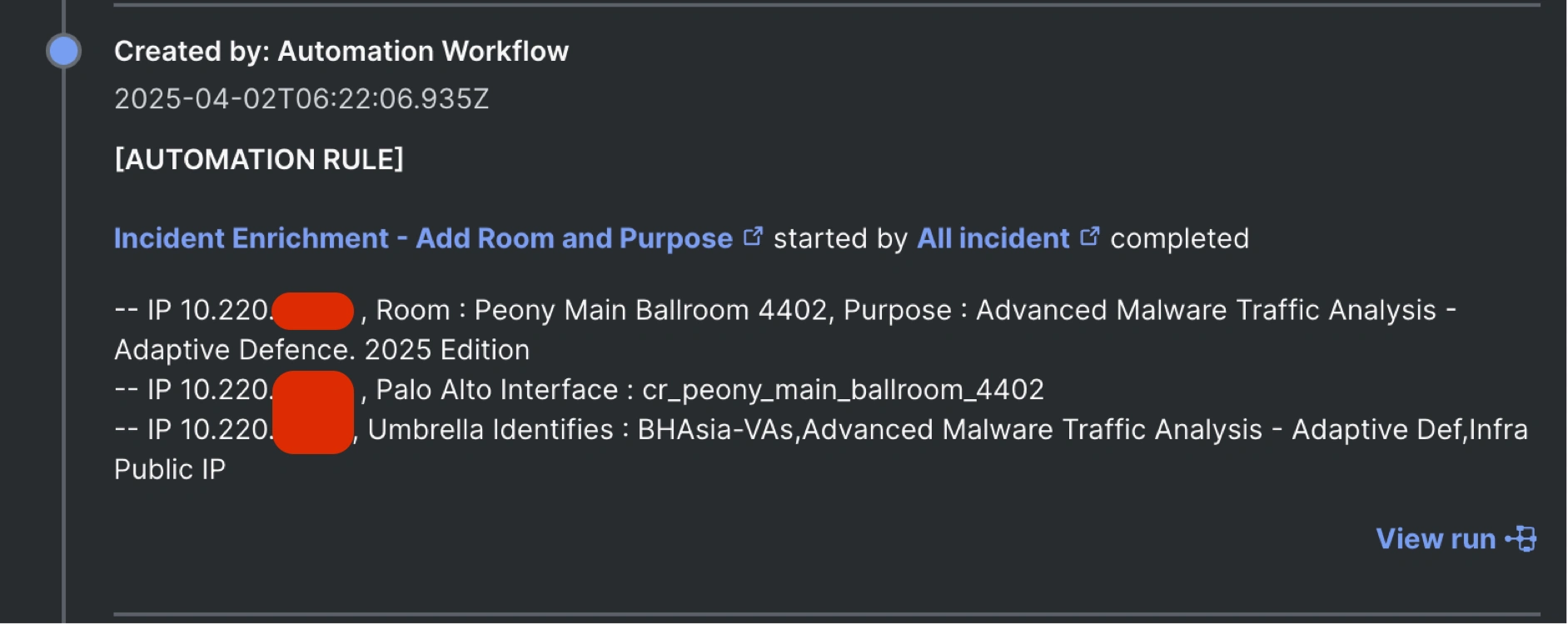
Subsequent step, our menace hunters as anticipated dived into Cisco Splunk Cloud to research the logs for any extra context. This investigation revealed necessary insights such because the site visitors from the system being in clear textual content, permitting the payload to be extracted. This discovery was key as a result of it revealed that this was not a typical phishing assault however a part of a coaching train.
Moreover, it was found a number of different gadgets from the identical subnet had been additionally speaking with the identical suspicious vacation spot. These gadgets exhibited almost similar site visitors patterns, additional supporting the idea that this was a part of a lab train.
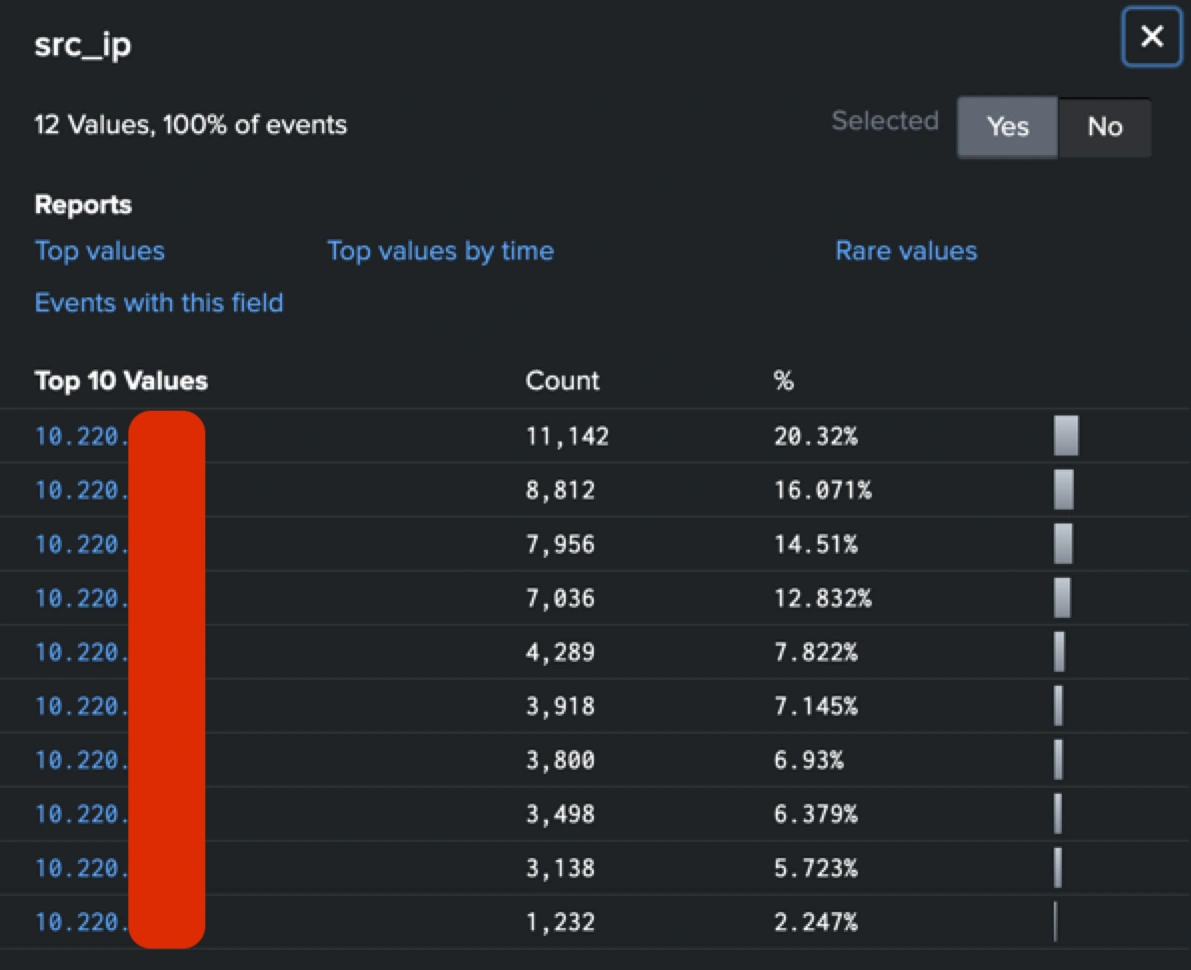
The variation within the site visitors quantity from the totally different gadgets instructed that varied college students had been at totally different phases of the lab.
Classes Discovered: The Misplaced Final A part of PICERL
With the ability to alter what’s offered to an analyst on the fly is among the most enjoyable elements of working occasions. In lots of organizations, “classes realized” from an incident or cluster of occasions are reviewed a lot later if in any respect, and suggestions enacted even later.
Within the Black Hat occasion surroundings, we’re persistently on the lookout for enhancements and making an attempt new issues; to check the bounds of the instruments we’ve available.
At Black Hat our mandate is to keep up a permissive surroundings, which leads to a really robust job in figuring out precise malicious exercise. As a result of there may be a lot exercise, time is at a premium. Something to scale back the noise and cut back the period of time in triage is of profit.
Repeated exercise was seen, equivalent to UPNP site visitors inflicting false positives. Positive, straightforward to identify however nonetheless it clogs up the work queue, as every occasion was at first making a single incident.
Noise equivalent to this causes frustration and that in flip may cause errors of judgement within the analyst. Subsequently, sharpening the analysts’ instruments is of premium significance.
All the BH staff is all the time open to strategies for enchancment to the processes and automation routines that we run on XDR.
Considered one of these was to position the Corelight NDR occasion payload straight into the outline of an occasion entry in XDR.
This straightforward change offered the main points wanted straight within the XDR dashboard, with none pivot into different instruments, shortening the triage course of.

The above instance reveals exercise within the Enterprise Corridor from demonstrator cubicles. It’s clear to see what seems to be repeated beaconing of a vendor system and was subsequently straightforward and fast to shut. Beforehand this required pivoting to the Splunk search to question for the occasion(s) and if the data was not obvious, then once more pivot to the submitting platform. Right here is the assessment of lesson realized, and the appliance of suggestions, thought of my technique of investigation and automatic these two steps.
Once more, Within the following instance reveals attention-grabbing site visitors which appears like exterior scanning utilizing ZDI instruments.
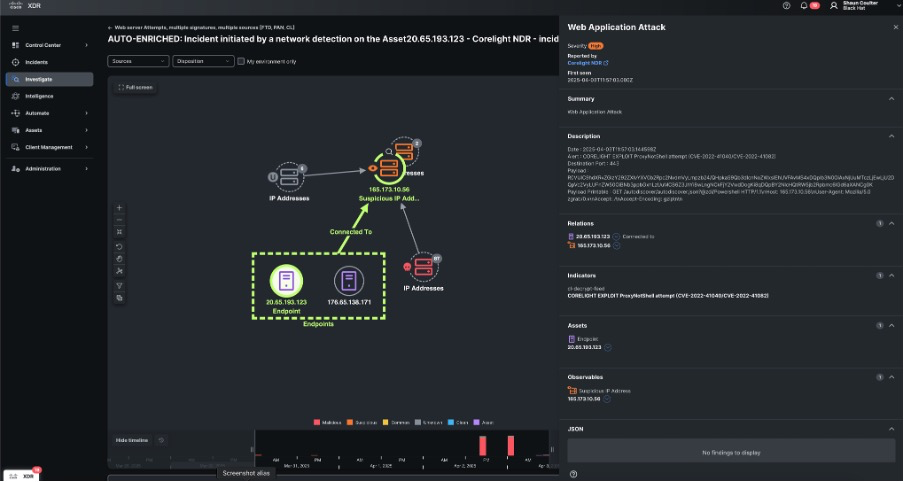
By having the payload type Corelight current within the occasion sequence within the XDR “Analyst workbench”, I used to be capable of see: /autodiscover/autodiscover.json which is usually utilized by Microsoft Alternate servers to offer autodiscovery data to purchasers like Outlook.
The presence of this path instructed a probing for Alternate providers.
- @zdi/Powershell Question Param — @zdi could check with the Zero Day Initiative, a identified vulnerability analysis program. This might point out a take a look at probe from a researcher, or a scan that mimics or checks for susceptible Alternate endpoints.
- Consumer-Agent: zgrab/0.x — zgrab is an open-source, application-layer scanner, typically used for internet-wide surveys (e.g., by researchers or menace actors).
The instrument is probably going a part of the ZMap ecosystem, which greater than doubtless implies that it’s somebody performing scanning or reconnaissance operation on the Public IP for the occasion, making it worthy to proceed monitoring.
The Occasion Title was “WEB APPLICATION ATTACK” not very descriptive however with our tremendous tuning by offering the element straight within the incident findings, the data was fairly actually at my fingertips.
Scareware, Video Streaming and Whatnot!
On 2nd April, one of many gadgets on the community reached out to a web site flagged as “Phishing” by Umbrella.
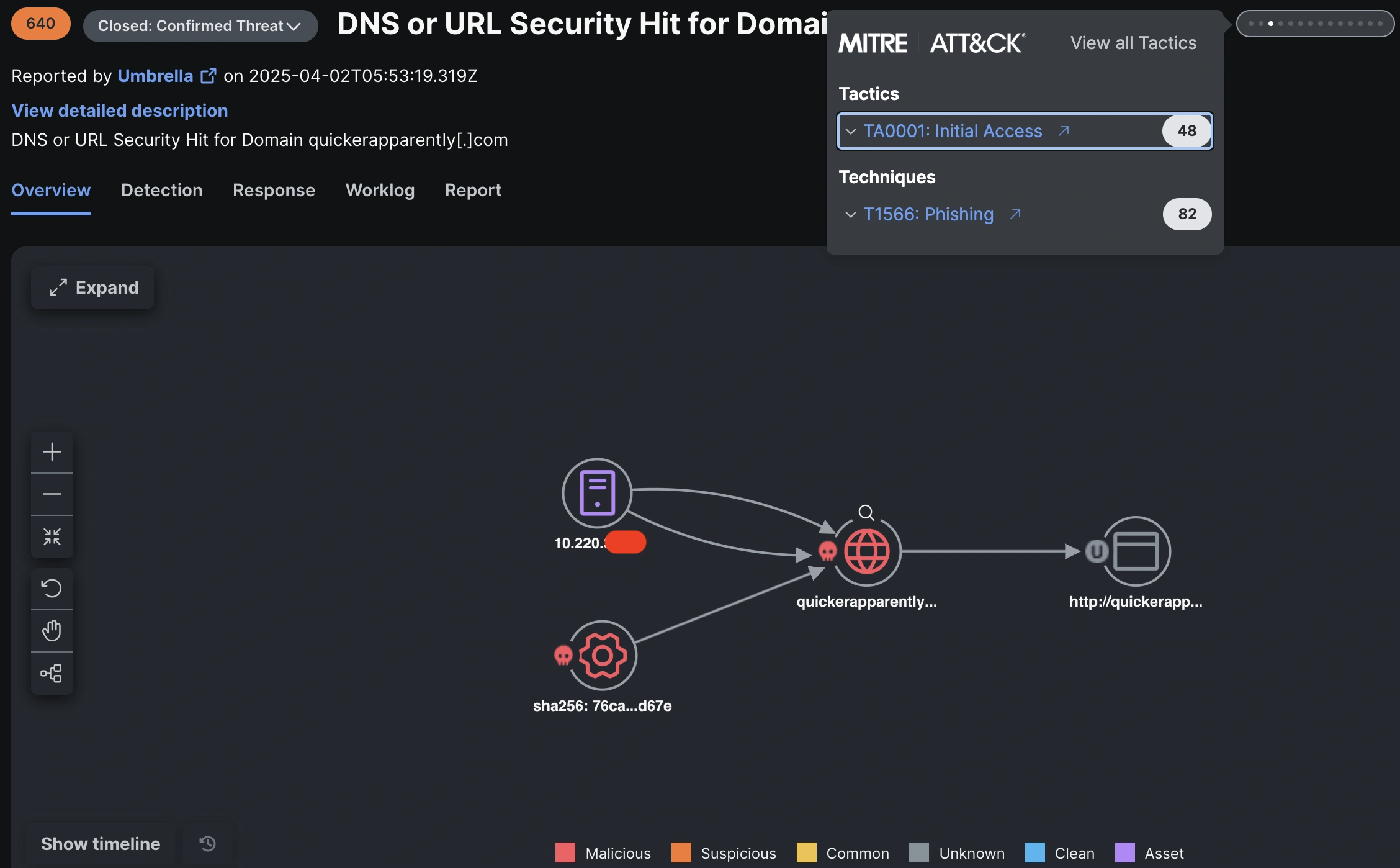
At first, it was suspected that the queries had been associated to a coaching class due to the timing of the area exercise. For instance, among the domains had been registered as just lately as a month in the past, with Umbrella exhibiting exercise starting solely on April 1st, coinciding with the beginning of the convention.
But when that had been the case, we’d count on to see many different attendees making the identical requests from the coaching Wi-Fi SSID. This was not the case — in actual fact, throughout the occasion solely a complete of 5 IPs making these DNS queries and/or internet connections had been seen, and solely a type of was linked to the coaching SSID. A kind of 5 gadgets was that of an Informa gross sales worker. A NOC chief contacted them, and so they acknowledged unintentionally clicking on a suspicious hyperlink.
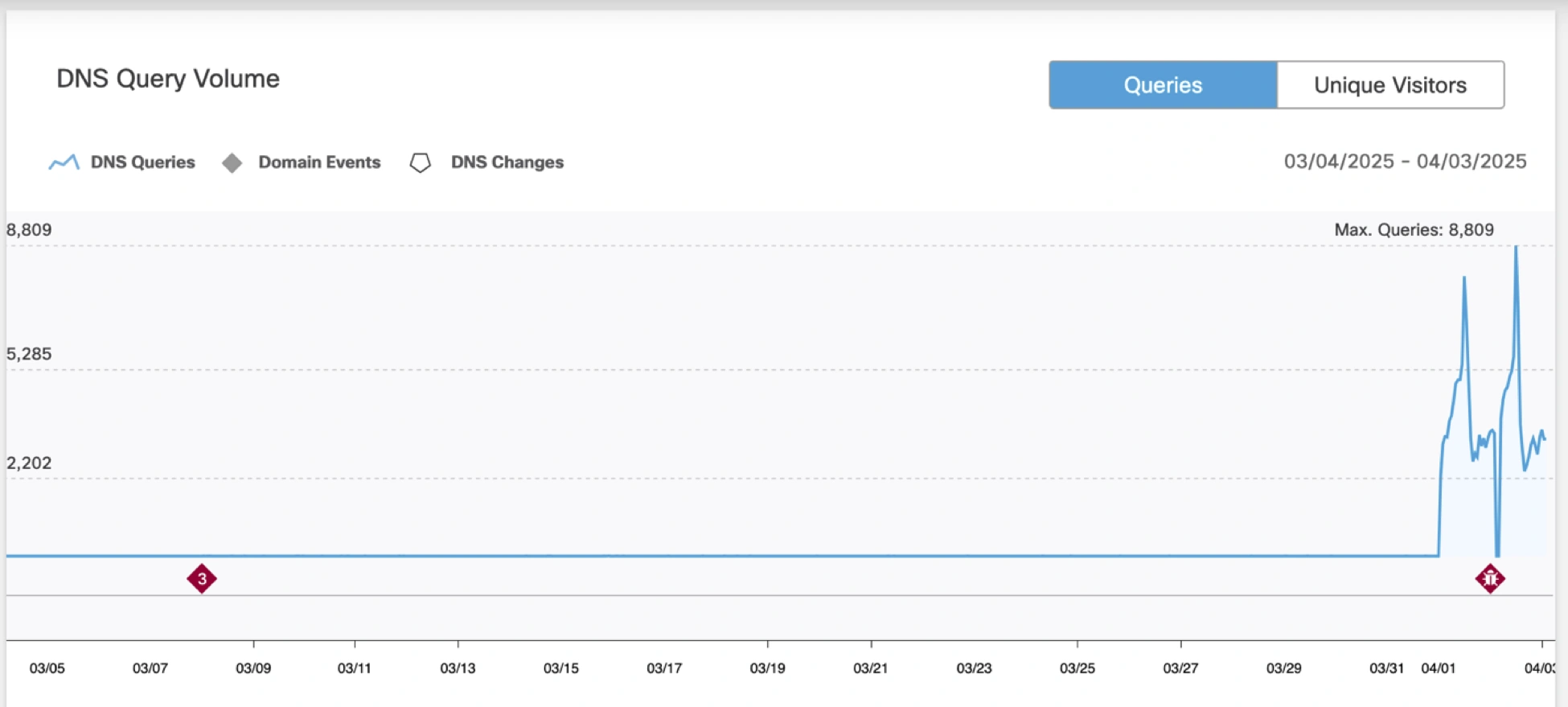
Christian Clasen expanded the search past the “Phishing” class and located heaps of searches for domains in a brief window of time for questionable classes of adware, malware and grownup websites.

On this system, this was adopted by a detour to a pirated video streaming web site (probably an unintended click on). This web site then kicked off a sequence of pops-up to varied web sites throughout the board together with over 700 DNS queries to grownup websites. We used Safe Malware Analytics to assessment the web site, with out getting contaminated ourselves.
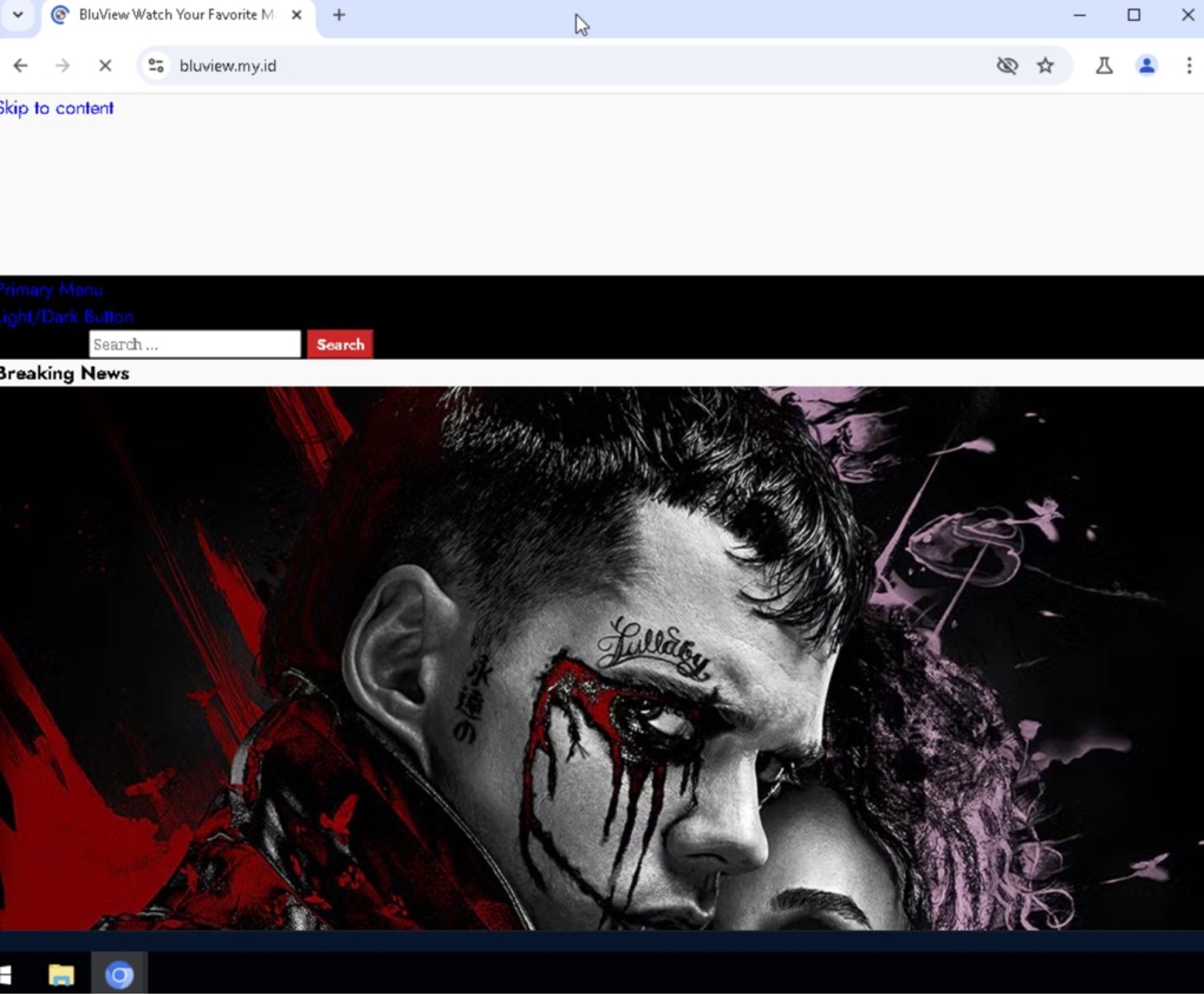
Contemplating this potential chain of actions on that system, the identical observable was detonated in Splunk Assault Analyzer for dynamic interplay and evaluation. The report for the video streaming web site reveals the positioning popularity being questionable together with indicators for phish kits and crypto funds current.

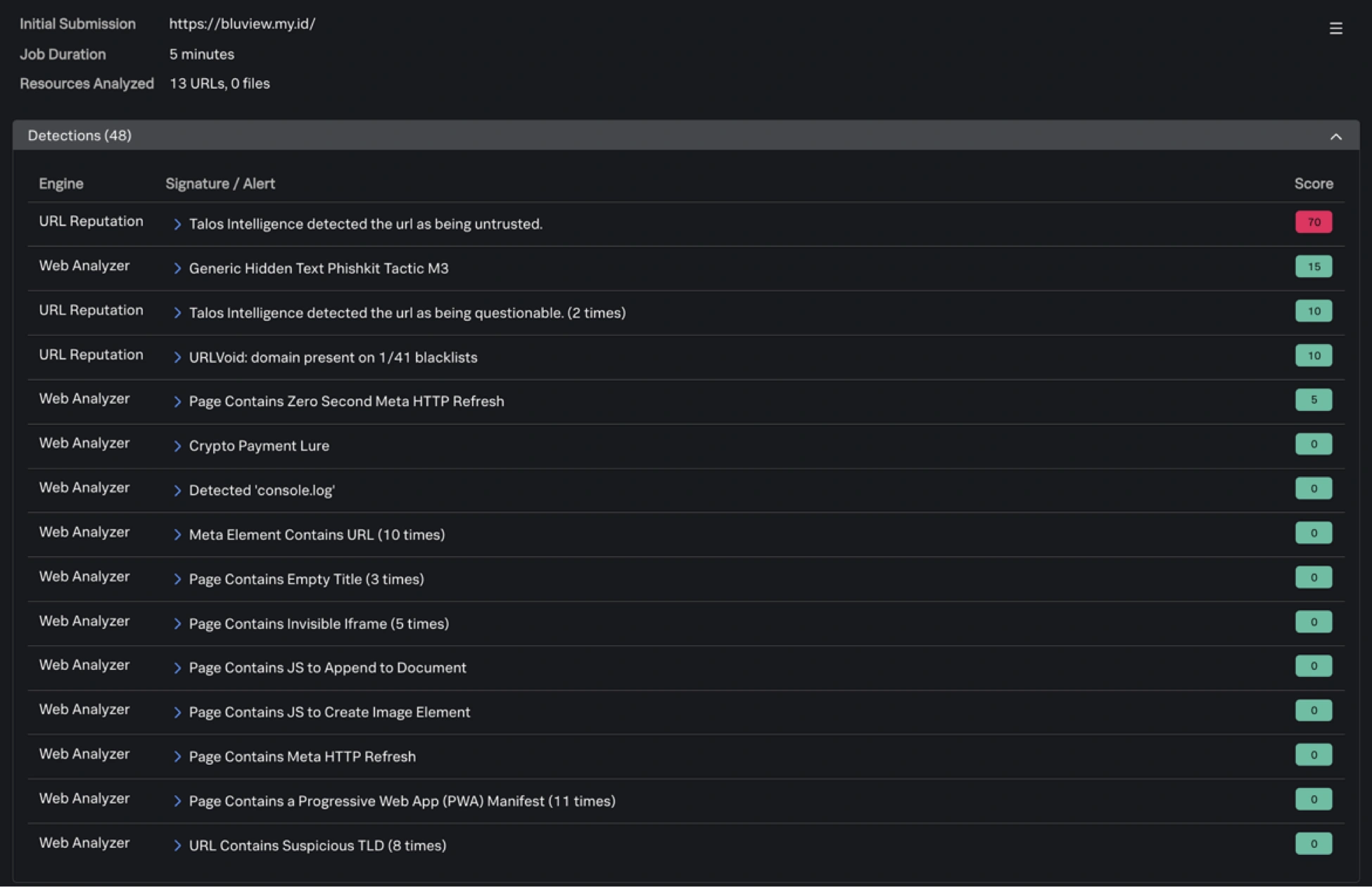
So, again to the query: Are these all linked? Wanting on the varied situations of such spurious DNS queries, Christian collated such web sites queried and the IPs they had been hosted at. DNS queries to:
- adherencemineralgravely[.]com
- cannonkit[.]com
- cessationhamster[.]com
- pl24999848[.]profitablecpmrate[.]com
- pl24999853[.]profitablecpmrate[.]com
- playsnourishbag[.]com
- resurrectionincomplete[.]com
- settlementstandingdread[.]com
- wearychallengeraise[.]com
- alarmenvious[.]com
- congratulationswhine[.]com
- markshospitalitymoist[.]com
- nannyirrationalacquainted[.]com
- pl24999984[.]profitablecpmrate[.]com
- pl25876700[.]effectiveratecpm[.]com
- quickerapparently[.]com
- suspectplainrevulsion[.]com
Which resolved to frequent infrastructure IPs:
- 172[.]240[.]108[.]68
- 172[.]240[.]108[.]84
- 172[.]240[.]127[.]234
- 192[.]243[.]59[.]13
- 192[.]243[.]59[.]20
- 192[.]243[.]61[.]225
- 192[.]243[.]61[.]227
- 172[.]240[.]108[.]76
- 172[.]240[.]253[.]132
- 192[.]243[.]59[.]12
That are identified to be related to the ApateWeb scareware/adware marketing campaign. The nameservers for these domains are:
- ns1.publicdnsservice[.]com
- ns2.publicdnsservice[.]com
- ns3.publicdnsservice[.]com
- ns4.publicdnsservice[.]com
That are authoritative for lots of of identified malvertising domains:
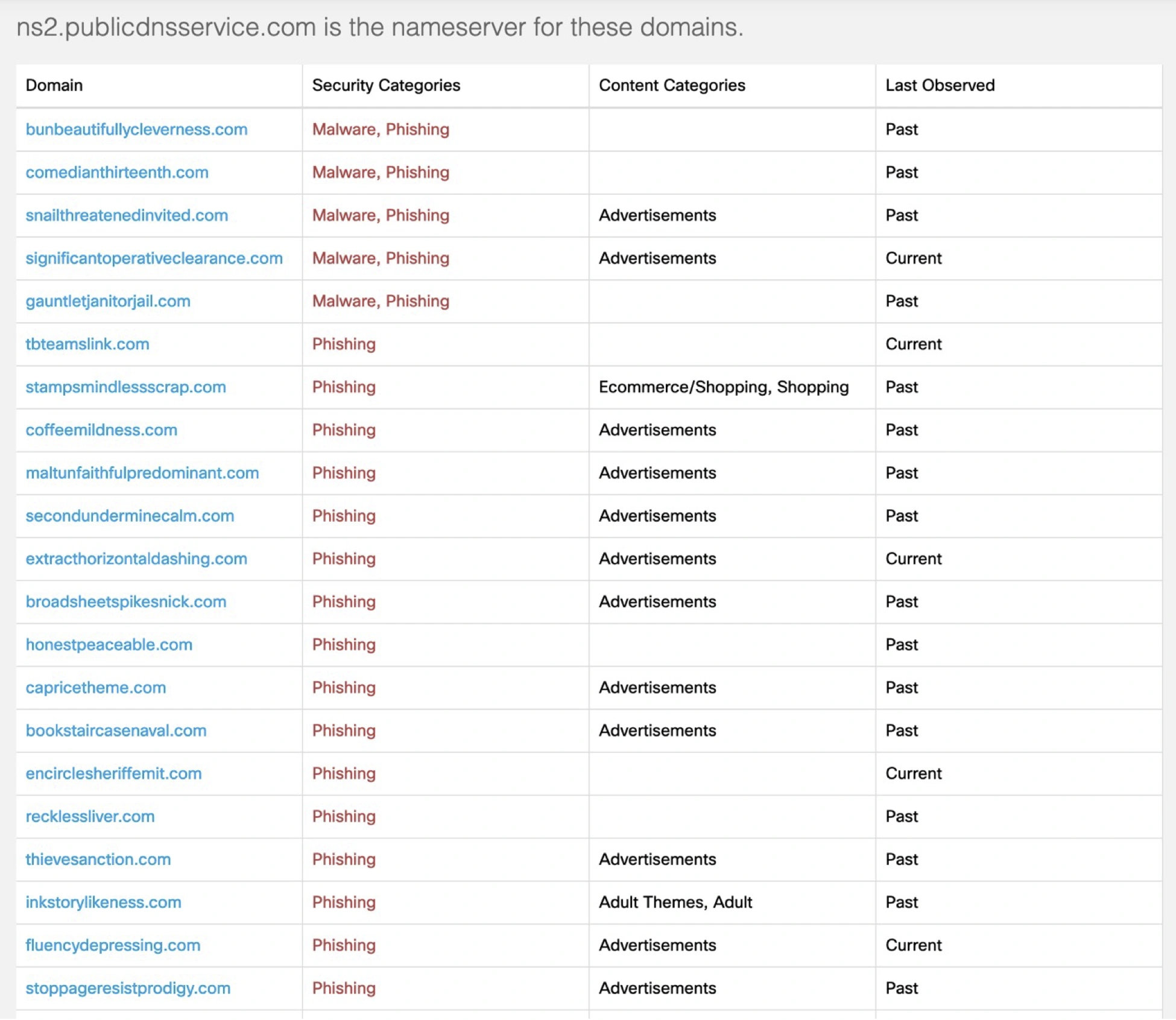
Provided that one affected individual acknowledged that that they had clicked on a suspicious hyperlink, leading to one of many occasions, we consider that these are unrelated to coaching and actually unrelated to one another. A Unit42 weblog will be referenced for the checklist of IOCs associated to this marketing campaign. Unit42’s put up notes, “The influence of this marketing campaign on web customers might be massive, since a number of hundred attacker-controlled web sites have remained in Tranco’s prime 1 million web site rating checklist.” Nicely, that may be a true optimistic within the SOC right here.
Trufflehunter Monero Mining Assaults
Authored by: Ryan MacLennan
As a part of doing a little extra testing and offering higher efficacy for our XDR product, we deployed a proof-of-value Firepower Menace Protection (FTD) and Firepower Administration Middle (FMC). It was receiving the identical SPAN site visitors that our sensor obtained for XDR Analytics, however it’s offering a totally totally different set of capabilities, these being the Intrusion Detection capabilities.
Beneath we will see a number of triggers, from a single host, on the FTD a couple of Trufflehunter Snort signature. The requests are going out to a number of exterior IP addresses utilizing the identical vacation spot port.

This was attention-grabbing as a result of it appears as if this consumer on the community was trying to assault these exterior servers. The query was, what’s trufflehunter, are these servers malicious, is the assault on function, or is it official site visitors right here at Black Hat for a coaching session or demo?
Taking one of many IP addresses within the checklist, I entered it into VirusTotal and it returned that it was not malicious. But it surely did return a number of subdomains associated to that IP. Taking the top-level area of these subdomains, we will do an additional search utilizing Umbrella.

Umbrella Examine says this area is a low threat and freeware/shareware. At this level we will say that Command and Management just isn’t in play. So why are we seeing hits to this random IP/area?

Taking the area for this investigation and popping it into Splunk Assault Analyzer (SAA), we will discover the positioning. Mainly, the proprietor of this area is an avid explorer of information and likes to tinker with tech, the principle area was used to host their weblog. The numerous subdomains that they had listed had been for the totally different providers they host for themselves on their web site. That they had an e-mail service, Grafana, admin login and lots of different providers hosted right here. They even had an about part so you might get to know the proprietor higher. For the privateness of the area proprietor, I’ll omit their web site and different data.
Now that we all know this IP and area are more than likely not malicious, the query remained of why they had been being focused. their IP tackle in Shodan, it listed their IP as having port 18010 open.

a number of different IPs that had been being focused, all of them had that very same port open. So, what’s that port used for and what CVE is the Snort signature referencing?

We see under that the trufflehunter signature is said to CVE-2018-3972. It’s a vulnerability that enables code execution if a particular model of the Epee library is used on the host. On this case, the susceptible library is usually used within the Monero mining utility.

Doing a search on Google confirmed that port 18080 is usually used for Monero peer-to-peer connections in a mining pool. However that’s based mostly off the AI abstract. Can we actually belief that?
Happening the outcomes, we discover the official Monero docs and so they definitely do say to open port 18080 to the world if you wish to be part of a mining pool.

We will see that there have been makes an attempt to get into these providers, however they weren’t profitable as there have been no responses again to the attacker? How is an attacker capable of finding servers world wide to carry out these assaults on?
The reply is pretty easy. In Shodan, you possibly can seek for IPs with port 18080 open. The attacker can then curate their checklist and carry out assaults, hoping some will hit. They most likely have it automated, so there may be much less work for them on this course of. How can we, as defenders and the on a regular basis individual, forestall ourselves from exhibiting up on an inventory like this?
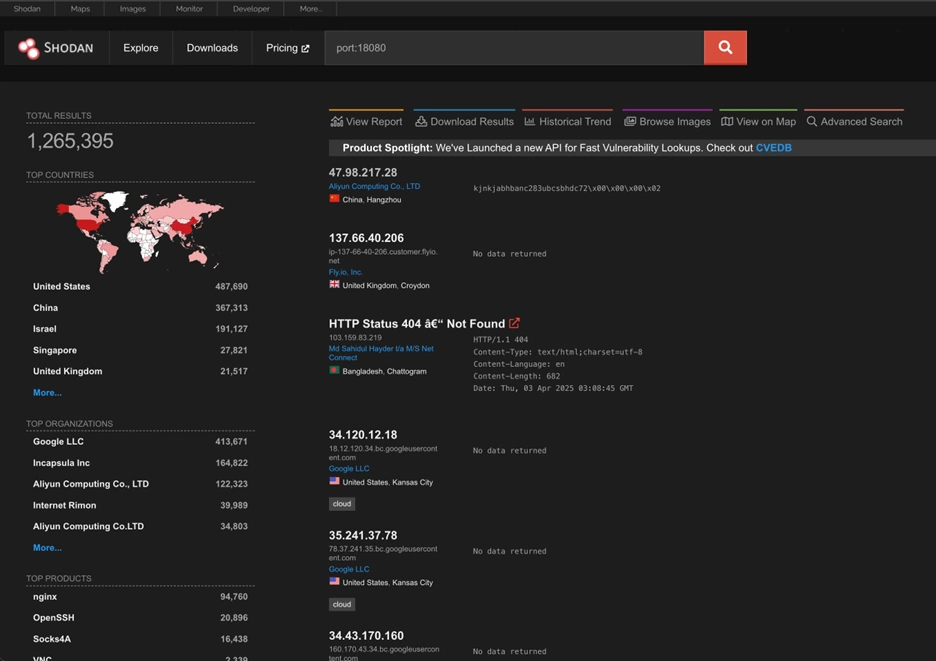
If you’re internet hosting your personal providers and have to open ports to the web, you must attempt to restrict your publicity as a lot as attainable.
To alleviate the sort of fingerprinting/scanning you must block Shodan scanners (should you can). They’ve a distributed system, and IPs change on a regular basis. You’ll be able to block scanning actions basically when you have a firewall, however there is no such thing as a assure that it’s going to forestall the whole lot.
When you’ve got an utility, you developed or are internet hosting, there are different choices like fail2ban, safety teams within the cloud, or iptables that can be utilized to dam these kind of scans. These choices can permit you to block all site visitors to the service besides from the IPs you need to entry it.
Options to opening the port to the Web can be to setup up tunnels from one web site to a different or use a service that doesn’t expose the port however permits distant entry to it by way of a subdomain.
Snort ML Triggered Investigation
Authored by: Ryan MacLennan
Throughout our time at Black Hat Asia, we made certain Snort ML (machine studying) was enabled. And it was positively price it. We had a number of triggers of the brand new Snort function the place it was capable of detect a possible menace within the http parameters of an HTTP request. Allow us to dive into this new detection and see what it discovered!

Wanting on the occasions, we will see a number of totally different IPs from a coaching class and one on the Normal Wi-Fi community triggering these occasions.

Investigating the occasion with the 192 tackle, we will see what it alerted on particularly. Right here we will see that it alerted on the ‘HTTP URI’ subject having the parameter of ‘?ip=%3Bifconfig’. This appears like an try to run the ifconfig command on a distant server. That is often executed after a webshell has been uploaded to a web site and it’s then used to enumerate the host it’s on or to do different duties like get a reverse shell for a extra interactive shell.

Within the packet knowledge we will see the complete request that was made.
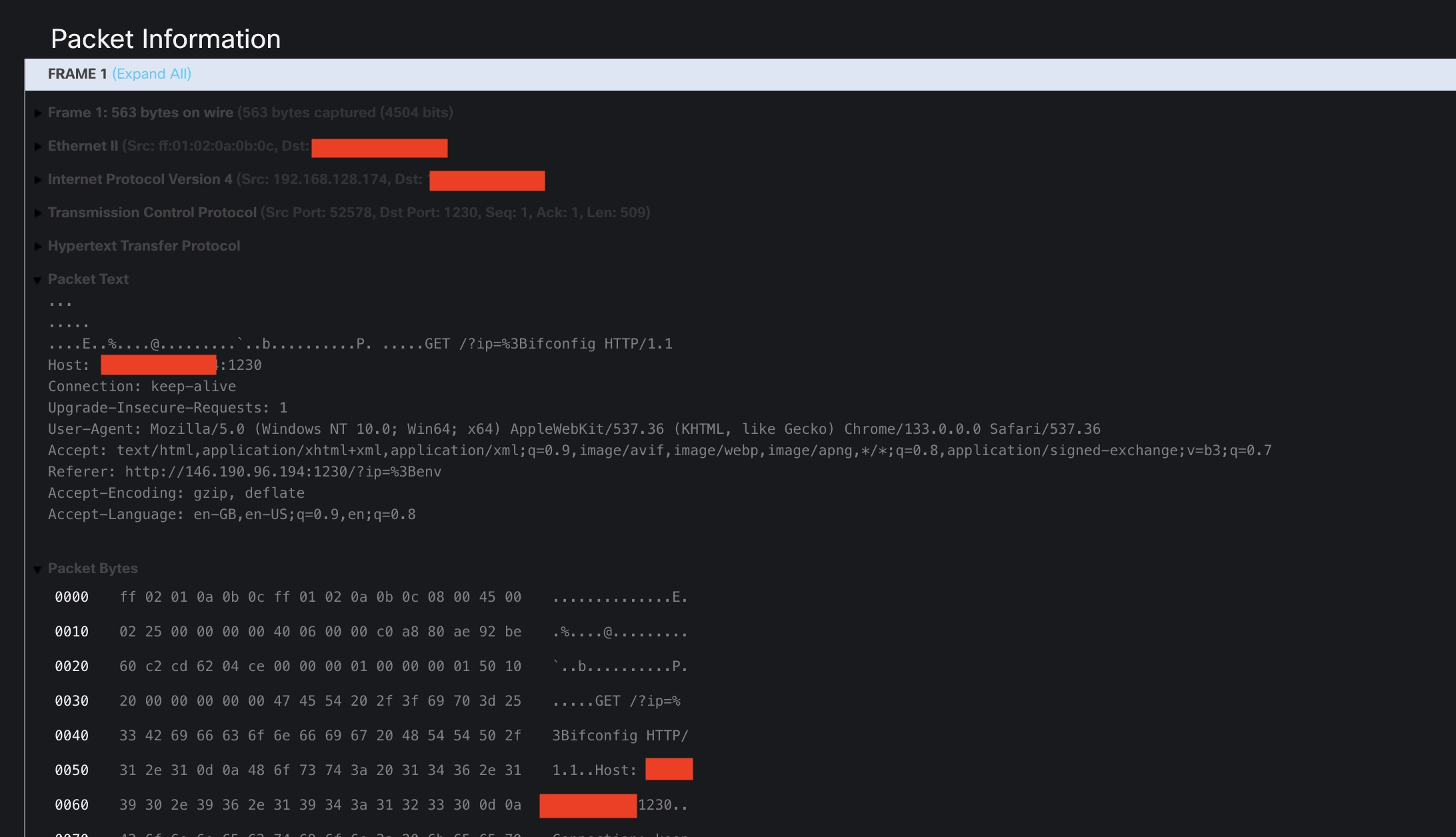
one other host that was in a coaching we will see that the Snort ML signature fired on one other command as effectively. That is precisely what we need to see, we all know now that the signature is ready to detect totally different http parameters and decide if they’re a menace. On this instance we see the attacker making an attempt to get a file output utilizing the command ‘cat’ after which the file path.

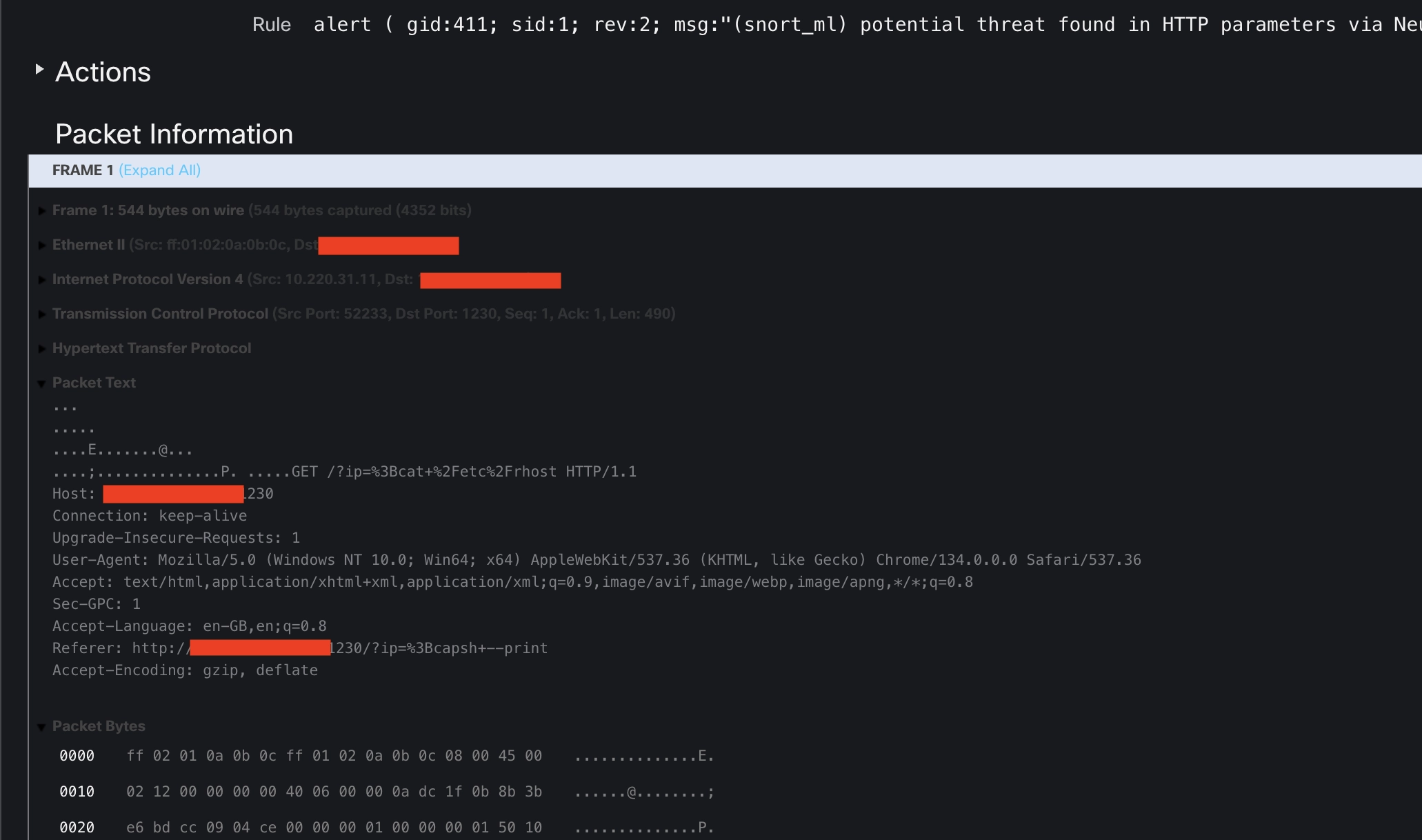
With this investigation, I used to be capable of decide the overall Wi-Fi consumer was part of the category as they had been utilizing the identical IP addresses to assault as the remainder of the category. This was attention-grabbing as a result of it was a category on pwning Kubernetes cluster purposes. We had been capable of ignore this particular occasion as it’s regular on this context (we name this a ‘Black Hat’ optimistic occasion) however we by no means would have seen these assaults with out Snort ML enabled. If I had seen this come up in my surroundings, I’d contemplate it a excessive precedence for investigation.
Some extras for you, we’ve some dashboard knowledge so that you can peruse and see the stats of the FTD. Beneath is the Safety Cloud Management dashboard.

Subsequent, we’ve the FMC overview. You’ll be able to see how excessive the SSL consumer utility was and what our encrypted visibility engine (EVE) was capable of establish.

Lastly, we’ve a dashboard on the highest international locations by IDS occasions.
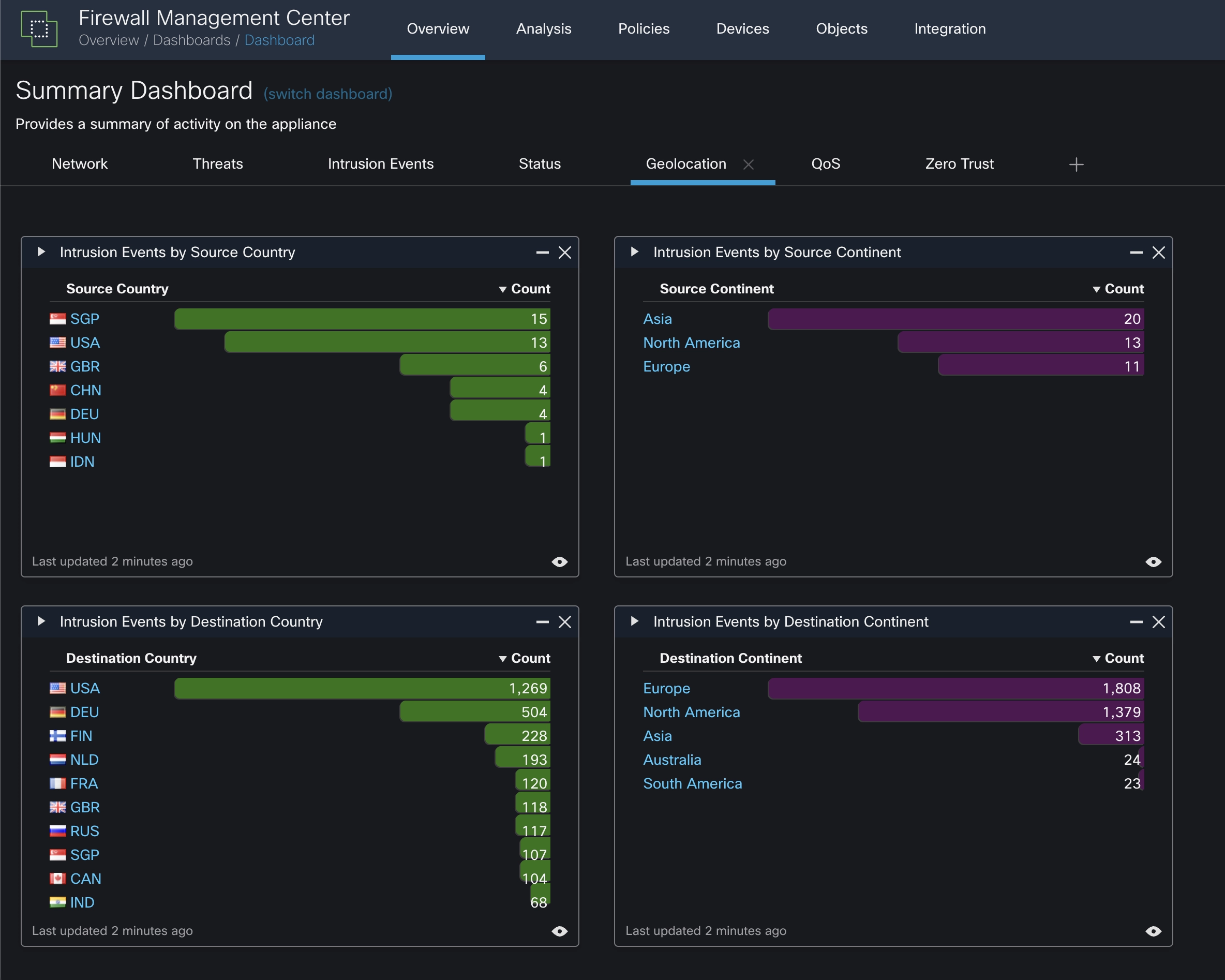
Id Intelligence
Authored by: Ryan MacLennan
Final yr, Black Hat requested Cisco Safety if we might be the Single Signal-On (SSO) supplier for all of the companions within the Black Hat NOC. The concept is to centralize our consumer base, make entry to merchandise simpler, present simpler consumer administration, and to point out role-based entry. We began the proof-of-value at Black Hat Asia 2024 and partially deployed at Black Hat Europe 2024. We’ve efficiently built-in with the companions within the Black Hat NOC to allow this concept began a yr in the past. Beneath is a screenshot of all of the merchandise we’ve built-in with from our companions and from Cisco.

On this screenshot above, we’ve the thought of the product homeowners having administrative entry to their very own merchandise and everybody else being a viewer or analyst for that product. Permitting every accomplice to entry one another’s instruments for menace searching. Beneath, you possibly can see the logins of assorted customers to totally different merchandise.

As part of this, we additionally present Id Intelligence, we use Id Intelligence to find out the belief worthiness of our customers and notify us when there is a matter. We do have an issue although. A lot of the customers aren’t at each Black Hat convention and the situation of the convention modifications every time. This impacts our customers’ belief scores as you possibly can see under.

Wanting on the screenshot under, we will see among the causes for the belief rating variations. Because the directors of the merchandise begin to prepare for the convention, we will see the logins begin to rise in February, March, and eventually April. Lots of the February and March logins are executed from international locations not in Singapore.

Beneath, we will see customers with their belief stage, what number of checks are failing, final login, and lots of different particulars. This can be a fast look at a consumer’s posture to see if we have to take any motion. Fortunately most of those are the identical challenge talked about earlier than.

On the finish of every present and after the companions can get the info, they want from their merchandise, we transfer all non admin customers from an energetic state to a disabled group, guaranteeing the Black Hat commonplace of zero-trust.
Cisco Unveils New DNS Tunneling Evaluation Strategies
Authored by: Christian Clasen
Cisco just lately introduced a new AI-driven Area Era Algorithm (DGA) detection functionality built-in into Safe Entry and Umbrella. DGAs are utilized by malware to generate quite a few domains for command and management (C2) communications, making them a essential menace vector by way of DNS. Conventional reputation-based programs wrestle with the excessive quantity of latest domains and the evolving nature of DGAs. This new resolution leverages insights from AI-driven DNS tunneling detection and the Talos menace analysis staff to establish distinctive lexical traits of DGAs. The result’s a 30% enhance in actual detections and a 50% enchancment in accuracy, lowering each false positives and negatives. Enhanced detection is routinely enabled for Safe Entry and Umbrella customers with the Malware Menace class energetic.
Engineers from Cisco offered the technical particulars of this novel method on the current DNS OARC convention. The presentation discusses a way for detecting and classifying Area Era Algorithm (DGA) domains in real-world community site visitors utilizing Passive DNS and Deep Studying. DGAs and botnets are launched, together with the basics of Passive DNS and the instruments employed. The core of the presentation highlights a monitoring panel that integrates Deep Studying fashions with Passive DNS knowledge to establish and classify malicious domains throughout the São Paulo State College community site visitors. The detector and classifier fashions, detailed in just lately revealed scientific articles by the authors, are a key element of this technique.
This can be a key functionality in environments just like the Black Hat convention community the place we must be inventive when interrogating community site visitors. Beneath is an instance of the detection we noticed at Black Hat Asia.
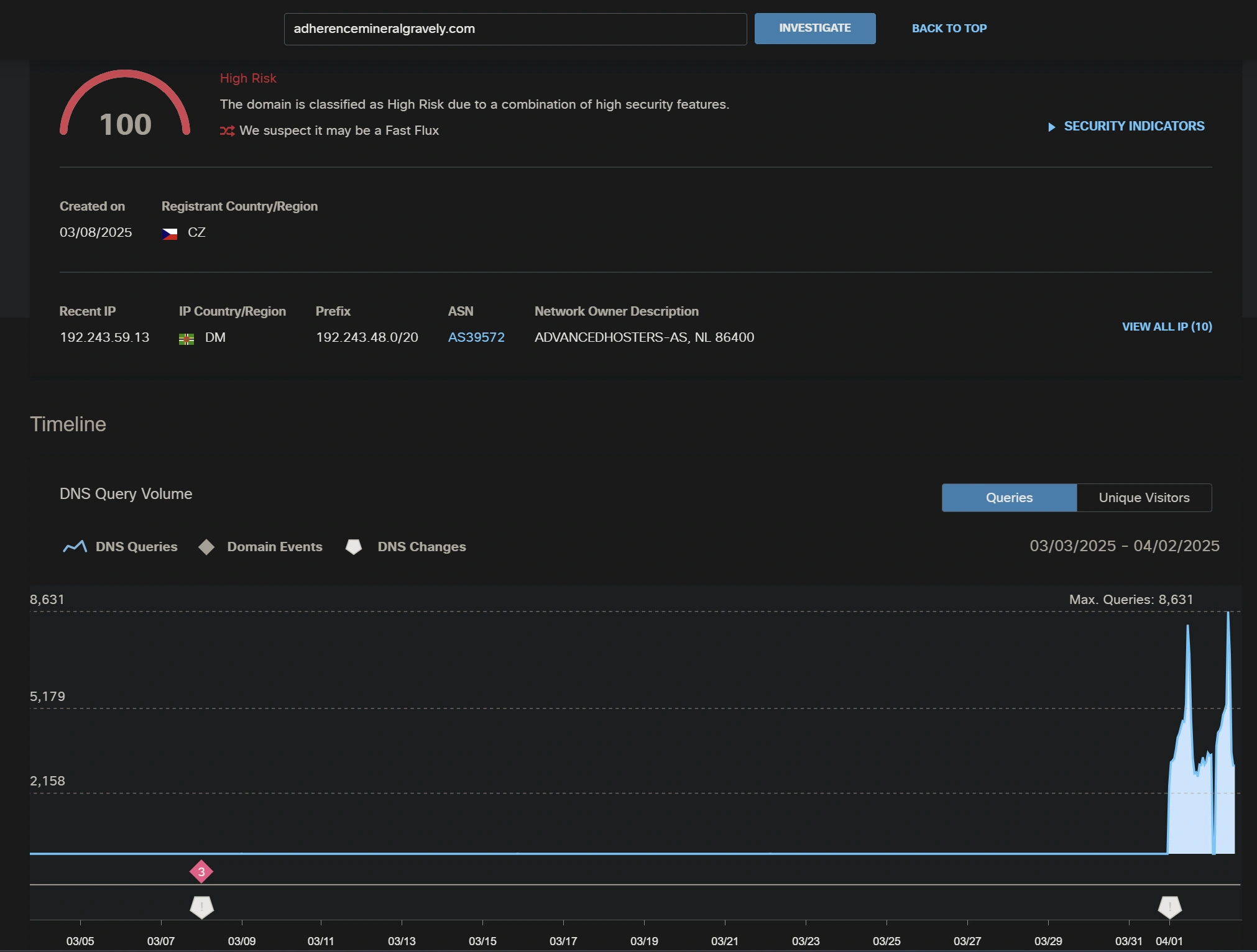
Area Title Service Statistics
Authored by: Christian Clasen and Justin Murphy
We set up digital home equipment as essential infrastructure of the Black Hat community, with cloud redundancy.

Since 2018, we’ve been monitoring DNS stats on the Black Hat Asia conferences. The historic DNS requests are within the chart under.


The Exercise quantity view from Umbrella provides a top-level stage look of actions by class, which we will drill into for deeper menace searching. On pattern with the earlier Black Hat Asia occasions, the highest Safety classes had been Malware and Newly Seen Domains.
In a real-world surroundings, of the 15M requests that Umbrella noticed, over 200 of them would have been blocked by our default safety insurance policies. Nevertheless, since this can be a place for studying, we usually let the whole lot fly. We did block the class of Encrypted DNS Question, as mentioned within the Black Hat Europe 2024 weblog.
We additionally monitor the Apps utilizing DNS, utilizing App Discovery.
- 2025: 4,625 apps
- 2024: 4,327 apps
- 2023: 1,162 apps
- 2022: 2,286 apps

App Discovery in Umbrella provides us a fast snapshot of the cloud apps in use on the present. Not surprisingly, Generative AI (Synthetic Intelligence) has continued to extend with a 100% enhance year-over-year.

Umbrella additionally identifies dangerous cloud purposes. Ought to the necessity come up, we will block any utility by way of DNS, equivalent to Generative AI apps, Wi-Fi Analyzers, or anything that has suspicious undertones.
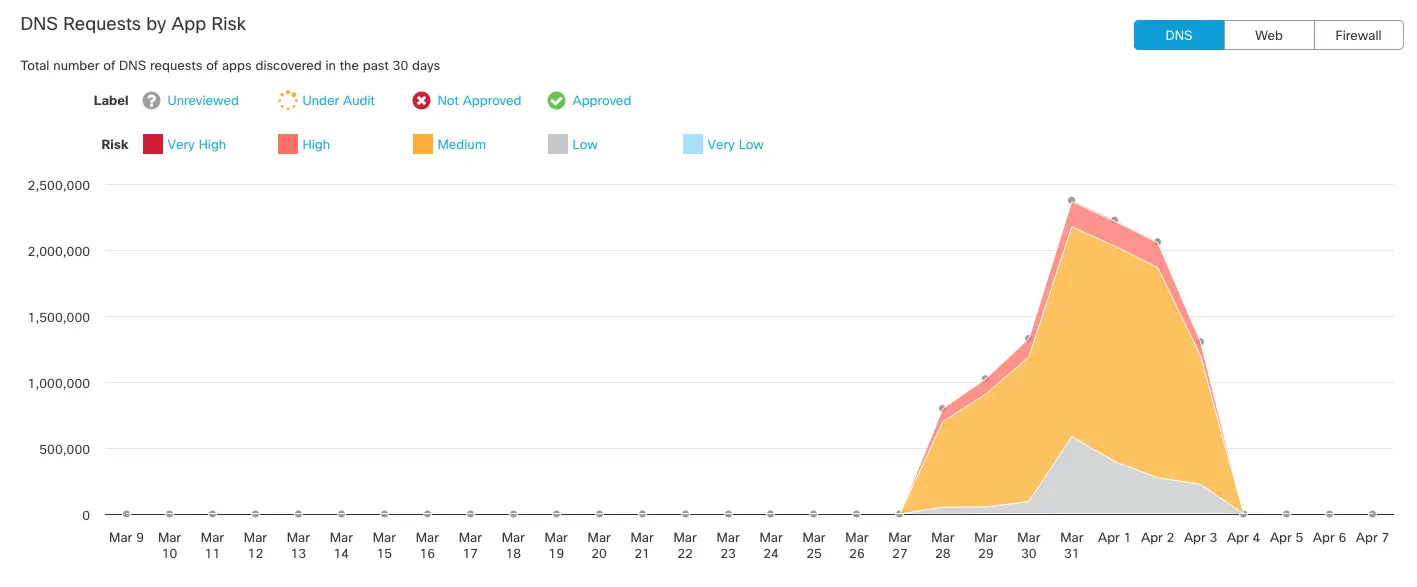
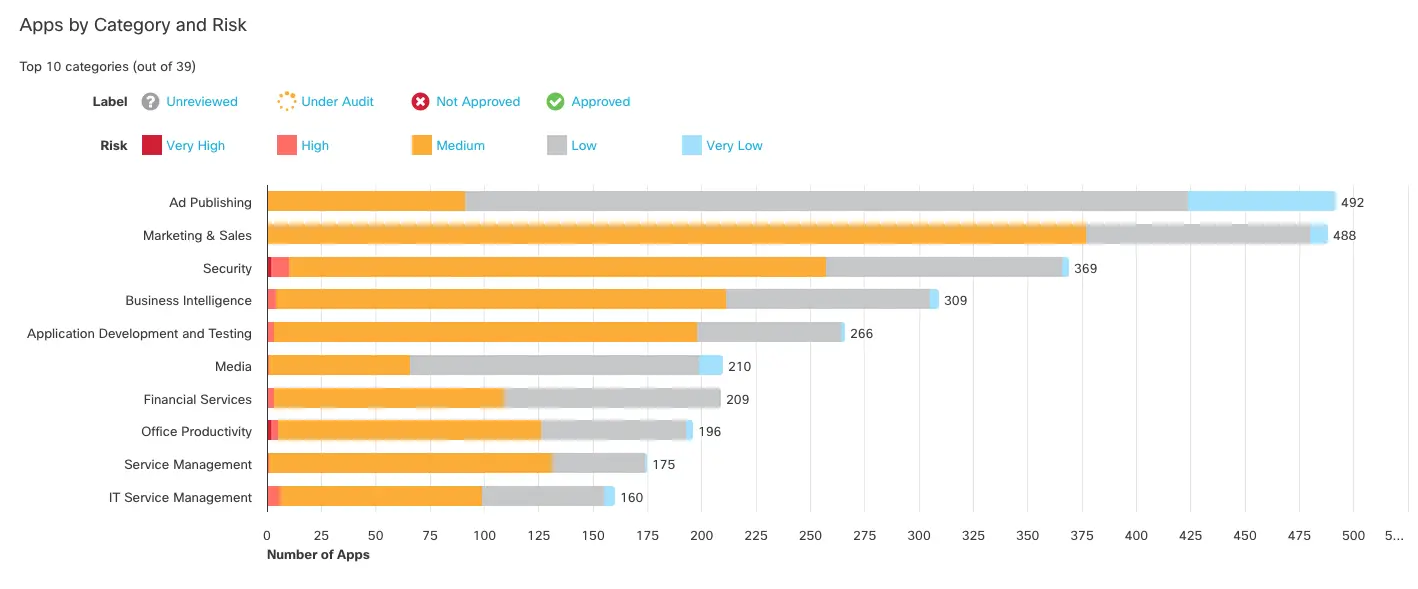
Once more, this isn’t one thing we’d usually do on our Normal Wi-Fi community, however there are exceptions. For instance, sometimes, an attendee will be taught a cool hack in one of many Black Hat programs or within the Arsenal lounge AND attempt to use mentioned hack on the convention itself. That’s clearly a ‘no-no’ and, in lots of instances, very unlawful. If issues go too far, we are going to take the suitable motion.
Throughout the convention NOC Report, the NOC leaders additionally report of the Prime Classes seen at Black Hat.
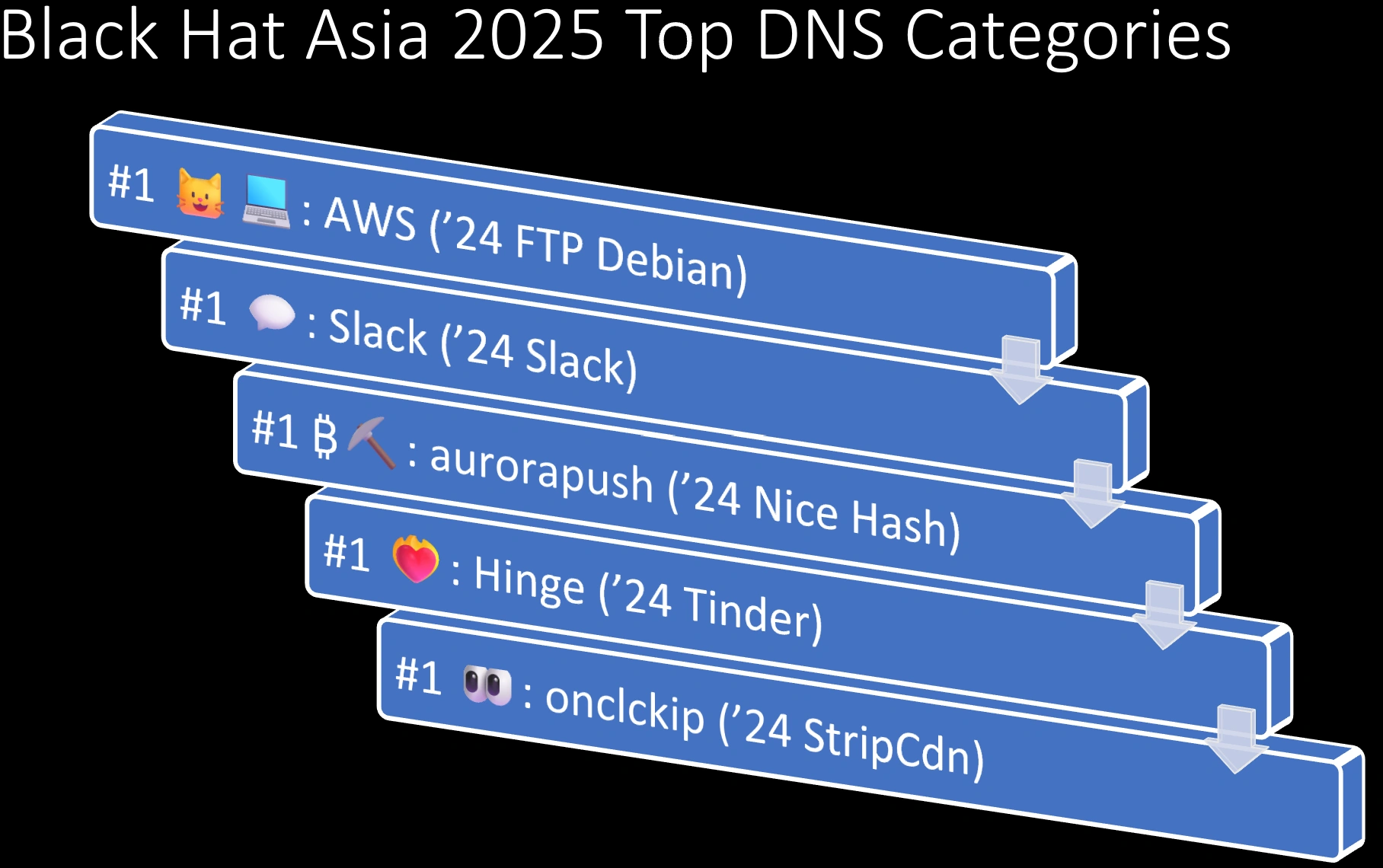
General, we’re immensely pleased with the collaborative efforts made right here at Black Hat Asia, by each the Cisco staff and all of the companions within the NOC.

We’re already planning for extra innovation at Black Hat USA, held in Las Vegas the primary week of August 2025.
Acknowledgments
Thanks to the Cisco NOC staff:
- Cisco Safety: Christian Clasen, Shaun Coulter, Aditya Raghavan, Justin Murphy, Ivan Berlinson and Ryan Maclennan
- Meraki Programs Supervisor: Paul Fidler, with Connor Loughlin supporting
- ThousandEyes: Shimei Cridlig and Patrick Yong
- Extra Assist and Experience: Tony Iacobelli and Adi Sankar

Additionally, to our NOC companions Palo Alto Networks (particularly James Holland and Jason Reverri), Corelight (particularly Mark Overholser and Eldon Koyle), Arista Networks (particularly Jonathan Smith), MyRepublic and all the Black Hat / Informa Tech employees (particularly Grifter ‘Neil Wyler’, Bart Stump, Steve Fink, James Pope, Michael Spicer, Jess Jung and Steve Oldenbourg).

About Black Hat
Black Hat is the cybersecurity trade’s most established and in-depth safety occasion collection. Based in 1997, these annual, multi-day occasions present attendees with the most recent in cybersecurity analysis, improvement, and tendencies. Pushed by the wants of the group, Black Hat occasions showcase content material straight from the group by means of Briefings shows, Trainings programs, Summits, and extra. Because the occasion collection the place all profession ranges and educational disciplines convene to collaborate, community, and talk about the cybersecurity subjects that matter most to them, attendees can discover Black Hat occasions in the US, Canada, Europe, Center East and Africa, and Asia. For extra data, please go to the Black Hat web site.
We’d love to listen to what you assume. Ask a Query, Remark Beneath, and Keep Linked with Cisco Safety on social!
Cisco Safety Social Channels
Share:


